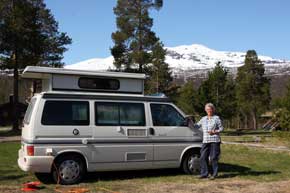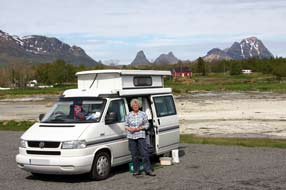|
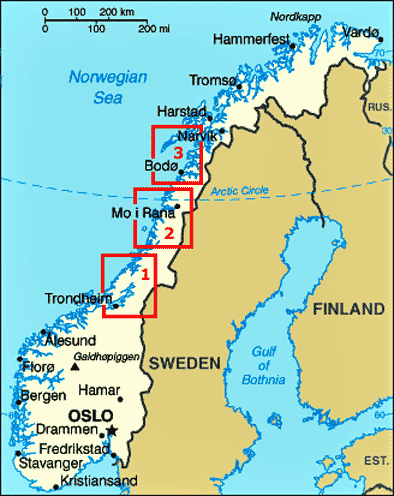 CAMPING
IN NORWAY 2014 - Trondheim, E6 north to Mo-i-Rana and Bodø, crossing the Arctic Circle
on Saltjell, and Skutvik for ferry to Lofoten
Islands: CAMPING
IN NORWAY 2014 - Trondheim, E6 north to Mo-i-Rana and Bodø, crossing the Arctic Circle
on Saltjell, and Skutvik for ferry to Lofoten
Islands:
Moving north towards Trondheim:
after our truly memorable if chill period in the mountains of Jotunheimen and
Dovrefjell, today we should begin the next phase of the trip moving north to the
coast; and this morning we heard the first cuckoo of the year. The
spectacular E6 road across Dovrefjell continued towards Trondheim down into the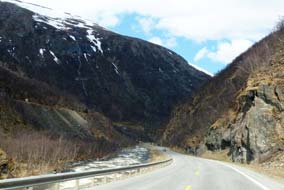 precipitous-sided defile of Drivdalen, with the railway line running along a
shelf in the narrow confines of the gorge on the far side of the river
torrent (see left). At the northern end of the pass, the valley sides opened up into
broader farming country leading to the small town of Oppdal whose residents we
had joined last week for their National Day celebratory procession up at
Hjerkinn on Dovrefjell. How warm the Spring air in the valley felt as we
descended from the still wintry high mountainous terrain. The Trondheim railway
continued to parallel the E6, following the line of valleys through
pine-forested rolling hill-country, and gradually the terrain broadened into
lowland farming country and small outlying towns as we approached the outskirts
of Trondheim. Traffic inevitably increased as we turned NE around the ring-road
through the city's conurbation, clocking up more tolls passing through more Autopass 'bomstasjons'.
precipitous-sided defile of Drivdalen, with the railway line running along a
shelf in the narrow confines of the gorge on the far side of the river
torrent (see left). At the northern end of the pass, the valley sides opened up into
broader farming country leading to the small town of Oppdal whose residents we
had joined last week for their National Day celebratory procession up at
Hjerkinn on Dovrefjell. How warm the Spring air in the valley felt as we
descended from the still wintry high mountainous terrain. The Trondheim railway
continued to parallel the E6, following the line of valleys through
pine-forested rolling hill-country, and gradually the terrain broadened into
lowland farming country and small outlying towns as we approached the outskirts
of Trondheim. Traffic inevitably increased as we turned NE around the ring-road
through the city's conurbation, clocking up more tolls passing through more Autopass 'bomstasjons'.
|
Click on the 3 highlighted areas of map
for
details of
Trondhein and NW Norway |
 |
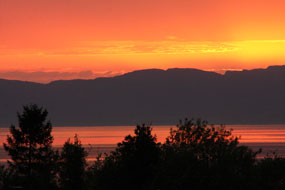 From the E6, we turned down to Vikhammer
Camping on the Trondheim fjord shore-line, our base for visiting the city. The
campsite reception was welcoming and had responded to our earlier email enquiry
about buses, but the camping area was sordidly unkempt, seemingly full of
semi-derelict static caravans with little space for visitors, and the air filled
with the noise of passing trains, aircraft, revving cars and rowdiness of
resident migrant workers. But it was a convenient base for visiting Trondheim
with ready bus access into the city, and we found a corner space to settle in
overlooking the fjord. The air temperature down at the coast was a balmy 25°,
and our first priority was to change out of our arctic gear! But the noise
levels made us long to be back in the peace and chill of the mountains. The
evening's highlight was a superb sunset across the fjord (see left) (Photo 1 - Sunset across Trondheim Fjord). From the E6, we turned down to Vikhammer
Camping on the Trondheim fjord shore-line, our base for visiting the city. The
campsite reception was welcoming and had responded to our earlier email enquiry
about buses, but the camping area was sordidly unkempt, seemingly full of
semi-derelict static caravans with little space for visitors, and the air filled
with the noise of passing trains, aircraft, revving cars and rowdiness of
resident migrant workers. But it was a convenient base for visiting Trondheim
with ready bus access into the city, and we found a corner space to settle in
overlooking the fjord. The air temperature down at the coast was a balmy 25°,
and our first priority was to change out of our arctic gear! But the noise
levels made us long to be back in the peace and chill of the mountains. The
evening's highlight was a superb sunset across the fjord (see left) (Photo 1 - Sunset across Trondheim Fjord).
First day in city of Trondheim:
facilities at Vikhammer Camping were kept spotlessly clean by the caretaker Eva,
a delightful Hungarian lady from Szeged on the River Tizsa. She insisted on
providing us with information to help our visit to Trondheim and was elated to
hear that we had visited her native city; she was clearly an educated lady who
spoke several European languages including fluent English and had insisted her
children received good education in England. A lovely lady with a warm
personality who took such a pride in her work, we really appreciated our chats
with her and on our last morning she brought us a whole plateful of her freshly
baked savoury scones called pogácsa in Magyar. She really was an asset to
the campsite and we hoped the owner duly appreciates that.
 Trondheim's history: the #38 bus runs regularly from Hommelvik along
the coast past Vikhammer into Trondheim, and although even seniors' ticket (honnør)
prices are expensive at 25 NOK per journey, the bus dropped us at Dronnings gata in the city centre. With just 160,000 residents, Trondheim is
Norway's 3rd largest city after Oslo and Bergen. Originally called Nidaros
(meaning mouth of the Nid River), the city gained the name Trondhjem (pronounced Trond-yem) since late medieval times. But in the early 20th century in a
fit of Norwegian nationalistic pride, the newly independent government tried to
revert to the name Nidaros, provoking outraged protests from Trondhjemers. A
compromise was duly reached with the name Trondheim. The city's origins go back
to 997 AD when the Viking King Olav Tryggvason moored his longship alongside a
sandbank at the mouth of the Nid River and established a farming settlement on
the triangular peninsula of land formed by the river's meander. In 1030, Trondheim's history: the #38 bus runs regularly from Hommelvik along
the coast past Vikhammer into Trondheim, and although even seniors' ticket (honnør)
prices are expensive at 25 NOK per journey, the bus dropped us at Dronnings gata in the city centre. With just 160,000 residents, Trondheim is
Norway's 3rd largest city after Oslo and Bergen. Originally called Nidaros
(meaning mouth of the Nid River), the city gained the name Trondhjem (pronounced Trond-yem) since late medieval times. But in the early 20th century in a
fit of Norwegian nationalistic pride, the newly independent government tried to
revert to the name Nidaros, provoking outraged protests from Trondhjemers. A
compromise was duly reached with the name Trondheim. The city's origins go back
to 997 AD when the Viking King Olav Tryggvason moored his longship alongside a
sandbank at the mouth of the Nid River and established a farming settlement on
the triangular peninsula of land formed by the river's meander. In 1030,
 Olav Haraldsson founded the cathedral at Nidaros, having with ruthless zeal imposed
Christianity on the country and incurred the opposition of pagan
landowners. They aligned themselves with Olav's rival, Knut king of Denmark and
England, and killed Olav at the Battle of Stiklestad. Desperately needing a
local hero to bolster its failing credibility, the early Norse church canonised
Olav, martyred it was claimed for his Christian beliefs; his remains were interred in Nidaros Cathedral which soon became a centre
of pilgrimage. The cult of St Olav lasted until Norway's subjugation by the
Danish kingdom and imposition of Lutheranism with the 1537 Reformation.
Trondheim had been Norway's royal and religious capital until 1217 with the
archbishops becoming rich and powerful. The city had developed and prospered as
a trading centre on the wedge of land in the Nidaros estuary, but the medieval wooden
city was destroyed by fire in 1681. The Danish governor commissioned a
Luxembourg military engineer Caspar de Cicignon to rebuild the city on a grid
plan with broad avenues as fire-breaks, and this design survives to give the
city centre the open feel seen today. Colourful wooden warehouses along the
banks of the Nid bear witness to Trondheim's mercantile wealth. In WW2 the
German invaders made Trondheim their main northern naval base, and the
battleship Tirpitz was anchored at Fættenfjord just to the north.
Trondheim managed to survive without major war damage, and today is a lively
university city. Olav Haraldsson founded the cathedral at Nidaros, having with ruthless zeal imposed
Christianity on the country and incurred the opposition of pagan
landowners. They aligned themselves with Olav's rival, Knut king of Denmark and
England, and killed Olav at the Battle of Stiklestad. Desperately needing a
local hero to bolster its failing credibility, the early Norse church canonised
Olav, martyred it was claimed for his Christian beliefs; his remains were interred in Nidaros Cathedral which soon became a centre
of pilgrimage. The cult of St Olav lasted until Norway's subjugation by the
Danish kingdom and imposition of Lutheranism with the 1537 Reformation.
Trondheim had been Norway's royal and religious capital until 1217 with the
archbishops becoming rich and powerful. The city had developed and prospered as
a trading centre on the wedge of land in the Nidaros estuary, but the medieval wooden
city was destroyed by fire in 1681. The Danish governor commissioned a
Luxembourg military engineer Caspar de Cicignon to rebuild the city on a grid
plan with broad avenues as fire-breaks, and this design survives to give the
city centre the open feel seen today. Colourful wooden warehouses along the
banks of the Nid bear witness to Trondheim's mercantile wealth. In WW2 the
German invaders made Trondheim their main northern naval base, and the
battleship Tirpitz was anchored at Fættenfjord just to the north.
Trondheim managed to survive without major war damage, and today is a lively
university city.
A walk around the old centre: the
central broad avenue of Munke gata led along the spacious main square of Torvet
with its statue of the city's legendary founder Olav Tryggvason perched high on
his stone column in full Viking chain mail and holding sword and orb, the
symbols of royal power (see above right) (Photo
2 - Torvet with Olav Tryggvason's statue). Present day Trondheimers and young students on bicycles
passed by indifferently. Nearby the sturdy-towered small church of Vår Frue
Kirke (Our Lady's Church), dating from 1207 is the only one of the original
foundations to have survived the 1681 great fire (see below left) (Photo
3 - Vår Frue Kirke (Our Lady's Church) of 1207). We turned into the pedestrianised Nordre gate, one of the original Viking settlement's main streets
and now the modern city's shopping street (see above left). The trees now almost in full leaf
gave the thoroughfare
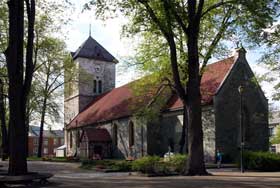 a pleasant air along with its shoppers and buskers
(Photo
4 - Trondheim's Nordre gate). Along
at the far end of Olav Tryggvason gate, we shopped for supper at a local fish
merchants and the old fish market of Ravnkloa, and sat to eat our lunch looking
across the fishing harbour
(Photo
5 - Trondheim's fishing harbour). a pleasant air along with its shoppers and buskers
(Photo
4 - Trondheim's Nordre gate). Along
at the far end of Olav Tryggvason gate, we shopped for supper at a local fish
merchants and the old fish market of Ravnkloa, and sat to eat our lunch looking
across the fishing harbour
(Photo
5 - Trondheim's fishing harbour).
 Trondheim's Hjemmefront Museet (Resistance
Museum): with the Cathedral closed this afternoon for a ceremonial
service attended by King Harold and Queen Sonja to commemorate the completion of
the organ restoration, we walked along to the free-entry Hjemmefront Museet
(Resistance Museum) whose main displays describe the carefully planned German
invasion of Norway in April 1940 with concerted sea-borne and aerial attacks on
Oslo, Kristiansand, Trondheim and Narvik, and subsequent Norwegian opposition to
the occupation. An outpost of the equivalent Oslo Museum which we had visited
earlier, the Trondheim museum was organised around a number of themes:
Quisling's radio broadcast announcing his take-over of government, life under
the 5 year occupation, and the development of organised resistance. One display
was devoted to the resistance hero Leif Larsen's abortive attempt to tow the
Royal Navy 2-man human torpedoes up Trondheim Fjord behind his fishing boat Arthur
to attack the Tirpitz at her Fættenfjord anchorage. Another display included an
enigma encoding machine (see right). What
particularly commended the Trondheim museum was its more frank treatment of the
issue of Norwegian collaboration and the number of Norwegians who volunteered both to
work for the Germans and be recruited into the SS to fight Bolshevism on
the Eastern Front as the propaganda posters urged. Another display was Trondheim's Hjemmefront Museet (Resistance
Museum): with the Cathedral closed this afternoon for a ceremonial
service attended by King Harold and Queen Sonja to commemorate the completion of
the organ restoration, we walked along to the free-entry Hjemmefront Museet
(Resistance Museum) whose main displays describe the carefully planned German
invasion of Norway in April 1940 with concerted sea-borne and aerial attacks on
Oslo, Kristiansand, Trondheim and Narvik, and subsequent Norwegian opposition to
the occupation. An outpost of the equivalent Oslo Museum which we had visited
earlier, the Trondheim museum was organised around a number of themes:
Quisling's radio broadcast announcing his take-over of government, life under
the 5 year occupation, and the development of organised resistance. One display
was devoted to the resistance hero Leif Larsen's abortive attempt to tow the
Royal Navy 2-man human torpedoes up Trondheim Fjord behind his fishing boat Arthur
to attack the Tirpitz at her Fættenfjord anchorage. Another display included an
enigma encoding machine (see right). What
particularly commended the Trondheim museum was its more frank treatment of the
issue of Norwegian collaboration and the number of Norwegians who volunteered both to
work for the Germans and be recruited into the SS to fight Bolshevism on
the Eastern Front as the propaganda posters urged. Another display was
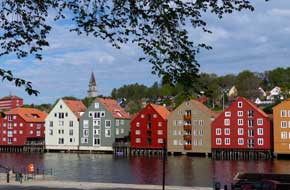 devoted
to Henry Rinnan, the infamous and sadistic Trondheim collaborator whose gang
cooperated with the Gestapo to betray, imprison, torture and murder several 100s
of Resistance members; he was executed for treason in 1947. A memorial hall
commemorated the 1,300 men and women of Central Norway killed during WW2. devoted
to Henry Rinnan, the infamous and sadistic Trondheim collaborator whose gang
cooperated with the Gestapo to betray, imprison, torture and murder several 100s
of Resistance members; he was executed for treason in 1947. A memorial hall
commemorated the 1,300 men and women of Central Norway killed during WW2.
Natural History and Archaeology Museum:
our next visit was to the Natural History and Archaeology Museum run by
Trondheim University, and again commendablly free-entry (the best museums usually
are!) where our interest was in the section devoted to Trondheim's post-Viking
age foundation and its Medieval period of development up to the 1681 great fire.
The museum's displays with well-researched, multi-lingual commentaries included
many of the archaeological finds covering aspects of life in the medieval city,
including the Kulisteinen from 1034 engraved with both a Christian cross and
runic inscription from the transitional period from pagan to Christian religion.
The quaintly named Kalvskinn gata led to the 1705 octagonal wooden Hospital-kirke
in the gardens of Trondheim's hospital, which according to its plaque dated back
to the city's original foundation. In this older part of the town, narrow
streets were lined with attractive wooden houses with clap-board frontages
painted in pastel shades (Photo
6 - Trondheim's old wooden houses); this led us back into Prinsens gate and Kongens gate
where trams trundled past.
Trondheim's medieval remains and mercantile
prosperity: back along through Torvet, where bright afternoon sunshine
now lit Olav Tryggvason's statue, we found the city library in Kongens gate
where the excavated remains of the 12th century St Olav's kirke are displayed
under the main entrance hall. Snorre Sturlasson, the
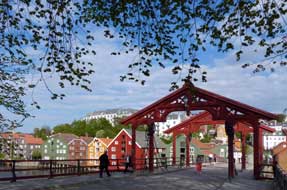 Icelandic chronicler in his Olav the Holy Saga reports that the church was built on the spit where Olav's
body was hidden on the night of his death at Stiklestad before being buried
further along the river where the Nidaros Cathedral now stands. Excavations
under the library revealed Icelandic chronicler in his Olav the Holy Saga reports that the church was built on the spit where Olav's
body was hidden on the night of his death at Stiklestad before being buried
further along the river where the Nidaros Cathedral now stands. Excavations
under the library revealed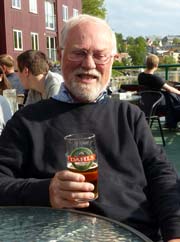 parts of the church and graveyard with the skeletal
remains of 3 adults and an infant now displayed in the ruins under the library's
forecourt. parts of the church and graveyard with the skeletal
remains of 3 adults and an infant now displayed in the ruins under the library's
forecourt.
Reaching the river's grassy embankment in
Kjøpmanns gata (Merchants Street), we could look across to the brightly painted
wooden 18th century gabled warehouses (see above left) supported on timber stilts which lined the
far bank of the Nidelva river (Photo
7 - 18th century wooden warehouses). Crossing the Gamle By Bru (Old Town Bridge)
(see left), we
took the opportunity to photograph the warehouses lit by bright afternoon sun from
the vantage point of the wooden footbridge (Photo
8 - Trondheim's Gamle By Bru). Across on the far side of the river,
a river-side pub was simply too much of a temptation after a long and rewarding
day of plodding the city streets. We treated ourselves to glasses of local
Trondheim pils from Dahl's brewery, sitting in the late afternoon sunshine
watching the boats go by (see right), before returning to the centre to catch our bus for
the half hour ride back out to Vikhammer Camping.
2nd day in Trondheim - the Hurtigrute coastal express:
waiting at the bus stop for our morning bus into the city, we
enjoyed another memorable encounter with James from Entebbe, a Ugandan who was
studying nursing here in Trondheim. He described how his father, a major in the
Ugandan army had survived the Idi Amin years and was now a pastor working with
Ugandan soldiers.
 A charmingly gentle lad, he spoke of missing his family and
hoped to bring his mother for a holiday in Norway since she could not
believe that people could walk on snow and ice! We got off the bus at the Bakke
Bru and set off in bright morning sunshine towards the harbour to wave off the
north-bound Hurtigrute coastal express. During previous visits to Northern
Norway, we had regularly made a point of seeing the ships which for over 100
years have sailed daily between Bergen and Kirkenes, calling at isolated coastal
communities and providing not only a unique tourist service but an essential
year-round delivery lifeline of both freight, supplies, mail and passengers; see Hurtigruten web site and our 2012 log of seeing the Hurtigruten at Berlevåg and Kjøllefjord
Trondheim is a key staging point on the A charmingly gentle lad, he spoke of missing his family and
hoped to bring his mother for a holiday in Norway since she could not
believe that people could walk on snow and ice! We got off the bus at the Bakke
Bru and set off in bright morning sunshine towards the harbour to wave off the
north-bound Hurtigrute coastal express. During previous visits to Northern
Norway, we had regularly made a point of seeing the ships which for over 100
years have sailed daily between Bergen and Kirkenes, calling at isolated coastal
communities and providing not only a unique tourist service but an essential
year-round delivery lifeline of both freight, supplies, mail and passengers; see Hurtigruten web site and our 2012 log of seeing the Hurtigruten at Berlevåg and Kjøllefjord
Trondheim is a key staging point on the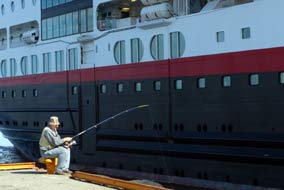 Hurtigruten schedule, and the daily
north-bound ship departs at noon. Following passengers returning to the
Hurtigruten quay,
we walked around to the dockside where M/S Midnatsol (Midnight Sun) stood waiting to depart
(see left) (Photo
9 - Hurtigrute coastal liner M/S Midnatsol). Fork-lift trucks
buzzed busily around moving pallets of every kind of cargo for loading into the
ship's conveyor down into the hold: stacks of tyres, oil drums, large packages
of hardware, but no foodstuffs or consumables at this stage of the route. Cars
were driven aboard including a new pick-up destined for some northern
destination, and we photographed the loading operation of freight for the Hurtigrute to
transport to isolated northern ports (Photo
10 - Loading freight on the Hurtigrute). Coaches brought passengers back for
re-boarding after their sight-seeing trip into Trondheim, and as noon
approached, the ship's horn sounded a lengthy warning of imminent sailing. Lines
were cast off, and M/S Midnatsol eased away from her berth to move out
into the main channel, dwarfing a lone fisherman who sat unmoved with his line
at the end of the pier (see right). Gathering pace, the Hurtigrute set off down the fjord to
resume her 'rapid route' northwards as we waved farewell. Maybe we shall see M/S Midnatsol
again as we ourselves journey up to the northern parts of Troms and Finmark. Hurtigruten schedule, and the daily
north-bound ship departs at noon. Following passengers returning to the
Hurtigruten quay,
we walked around to the dockside where M/S Midnatsol (Midnight Sun) stood waiting to depart
(see left) (Photo
9 - Hurtigrute coastal liner M/S Midnatsol). Fork-lift trucks
buzzed busily around moving pallets of every kind of cargo for loading into the
ship's conveyor down into the hold: stacks of tyres, oil drums, large packages
of hardware, but no foodstuffs or consumables at this stage of the route. Cars
were driven aboard including a new pick-up destined for some northern
destination, and we photographed the loading operation of freight for the Hurtigrute to
transport to isolated northern ports (Photo
10 - Loading freight on the Hurtigrute). Coaches brought passengers back for
re-boarding after their sight-seeing trip into Trondheim, and as noon
approached, the ship's horn sounded a lengthy warning of imminent sailing. Lines
were cast off, and M/S Midnatsol eased away from her berth to move out
into the main channel, dwarfing a lone fisherman who sat unmoved with his line
at the end of the pier (see right). Gathering pace, the Hurtigrute set off down the fjord to
resume her 'rapid route' northwards as we waved farewell. Maybe we shall see M/S Midnatsol
again as we ourselves journey up to the northern parts of Troms and Finmark.
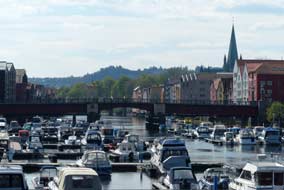 A walk through Nedre Elvehavn and
Baklandet:
crossing the Verftsbru footbridge (see left), decorated in tastefully Scandinavian style
with planters of scented pansies, we reached the former shipyard and industrial
workshop area of Nedre Elvehavn which closed in the 1990s and is now filled with A walk through Nedre Elvehavn and
Baklandet:
crossing the Verftsbru footbridge (see left), decorated in tastefully Scandinavian style
with planters of scented pansies, we reached the former shipyard and industrial
workshop area of Nedre Elvehavn which closed in the 1990s and is now filled with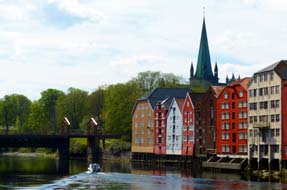 popular waterside bars and restaurants busy in the bright lunchtime sunshine (Photo
11 - Trendy cafés of Nedre Elvehavn).
Just 2 dockside cranes, retained as purely decorative pieces of industrial
archaeology, were the only reminder of the Trondhjems Mekaniske Værksted
shipyard which was once the city's largest employer. We crossed the bridge by
the lock-gates of the former dock basin and returned past yuppy apartment blocks
to the Bakkebru main city bridge to continued our ambling past the brightly
painted wooden houses of the former working class district of Baklandet, now a
trendy street of cafés and coffee shops. The cobbled streets showed further sign
of Trondheim's characteristically cycle-friendly policies with lanes of smooth
flagstones along the cobbles
(Photo
12 - Cobbled streets of Baklandet). At several points, gaps and alleyways between the
wooden houses led to balconies looking out over the river to the brightly
painted timber warehouses which lined the opposite Kjøpmanns gata embankment
(see right).
This finally led us to the little square by Gamle By Bru which we had reached
yesterday.
popular waterside bars and restaurants busy in the bright lunchtime sunshine (Photo
11 - Trendy cafés of Nedre Elvehavn).
Just 2 dockside cranes, retained as purely decorative pieces of industrial
archaeology, were the only reminder of the Trondhjems Mekaniske Værksted
shipyard which was once the city's largest employer. We crossed the bridge by
the lock-gates of the former dock basin and returned past yuppy apartment blocks
to the Bakkebru main city bridge to continued our ambling past the brightly
painted wooden houses of the former working class district of Baklandet, now a
trendy street of cafés and coffee shops. The cobbled streets showed further sign
of Trondheim's characteristically cycle-friendly policies with lanes of smooth
flagstones along the cobbles
(Photo
12 - Cobbled streets of Baklandet). At several points, gaps and alleyways between the
wooden houses led to balconies looking out over the river to the brightly
painted timber warehouses which lined the opposite Kjøpmanns gata embankment
(see right).
This finally led us to the little square by Gamle By Bru which we had reached
yesterday.
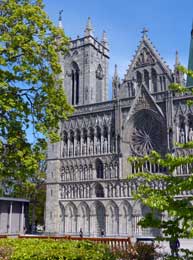 Trondheim's Nidaros Cathedral:
back across the footbridge, we walked up to Nidaros Cathedral whose
apparently small size and grey stonework belie its reputation as Northern
Europe's masterpiece of Medieval Gothic architecture (see left). Dedicated to St Olaf with
its altar set over the saint's grave, the original Trondheim's Nidaros Cathedral:
back across the footbridge, we walked up to Nidaros Cathedral whose
apparently small size and grey stonework belie its reputation as Northern
Europe's masterpiece of Medieval Gothic architecture (see left). Dedicated to St Olaf with
its altar set over the saint's grave, the original 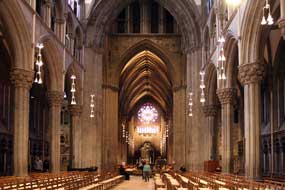 stone Cathedral of Nidaros,
the earliest parts dating from 1153 when Norway became a separate bishopric, has
suffered several fires over the centuries along with the upheavals of the
Reformation which robbed the Church of its riches. The original Gothic transept
built around 1180 shows Anglo-Norman influences with many of the craftsmen and
stonemasons brought over from England. The Cathedral's crowning glory is the
magnificent west end façade and rose window (Photo
13 - West end façade of Nidaros Cathedral) which, although in the early
Gothic style of the 13th century, in fact date from the 19th century
(Photo
14 - Detail of west end façade). Along with
its architectural rival at Uppsala in Sweden which we visited last year, Nidaros
Cathedral claims the glory of being Scandinavia's largest medieval structure. stone Cathedral of Nidaros,
the earliest parts dating from 1153 when Norway became a separate bishopric, has
suffered several fires over the centuries along with the upheavals of the
Reformation which robbed the Church of its riches. The original Gothic transept
built around 1180 shows Anglo-Norman influences with many of the craftsmen and
stonemasons brought over from England. The Cathedral's crowning glory is the
magnificent west end façade and rose window (Photo
13 - West end façade of Nidaros Cathedral) which, although in the early
Gothic style of the 13th century, in fact date from the 19th century
(Photo
14 - Detail of west end façade). Along with
its architectural rival at Uppsala in Sweden which we visited last year, Nidaros
Cathedral claims the glory of being Scandinavia's largest medieval structure.
Entering the Cathedral's gloomy interior
(see right) (Photo
15 - Nidaros Gothic interior), we
examined the newly restored organ's consol with its 4 manuals and complex array
of stops and couplers which was being tested by one of the organ builders.
Having viewed the rose window at the western end of the nave (Photo
16 - Organ and rose window), we went to the
east end to photograph the 14th century altar frontal painting hidden away in a
small chapel off the ambulatory. Created at a time when few Norwegians could
read or write, the cult of St Olaf had to be promoted pictorially; this altar
painting is the oldest surviving representation of St Olaf's life, or rather his
death at Stiklestad. The 3rd of the 4 panels showed Olaf being stabbed
mercilessly by vengeful soldiers, his death being construed as Christian
martyrdom and justification for canonisation. The 4th panel portrays church
officials exhuming Olaf's uncorrupted body and declaring his sainthood (see
right). What is
not to be seen now is the object of medieval pilgrims' veneration, St Olaf's
silver reliquary casket which originally
rested under the Cathedral's altar; it was removed to Copenhagen after the 1537
Reformation and unceremoniously melted down for coinage. and justification for canonisation. The 4th panel portrays church
officials exhuming Olaf's uncorrupted body and declaring his sainthood (see
right). What is
not to be seen now is the object of medieval pilgrims' veneration, St Olaf's
silver reliquary casket which originally
rested under the Cathedral's altar; it was removed to Copenhagen after the 1537
Reformation and unceremoniously melted down for coinage.
Outside we sat awhile in the afternoon sunshine
gazing up at the glories of the west end façade with its multiplicity of
statuettes lined up in rows. From the Cathedral we ambled around through the
parkland above the river embankment above the Nidelva's meander where students
sunbathed or revised for exams in the warm Spring sunshine. The riverside path
led us round behind the Cathedral back to the Gamle By Bru.
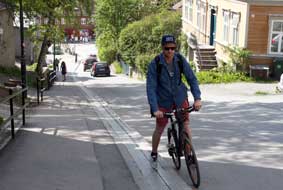 Trondheim's Trampe-Sykkelheis cycle-lift and
the Kristiansten Fortress:
crossing the bridge once more, we faced the ultra-steep climb up the Brubakken
hill to reach the Kristiansten Fortress. Cyclists tackling the hill have no such
problems since the Trondheim authorities have provided the world's only
cycle-lift, the Trampe-Sykkelheis, another of the cycle-friendly city's curiosities (Photo
17 - Trondheim's Trampe-Sykkelheis). This low-tech device consists of a
powered footplate which rises up the hill within a metal groove set in the
tarmac; cyclists sit on their bike with their left foot on the cycle pedal and
right foot resting against the footplate which pushes them up the steep slope, providing that the cyclist can
keep their balance! The secret is to keep
the right leg outstretched and body tilted forward, as we observed from the
regular users of the cycle-lift being propelled up the hill (see left). We unaided
pedestrians trudged slowly up the slope, and at the top continued up past the
pleasant wooden cottages of Baklandet to reach the Kristiansten Festning
(Fortress). The fortress dates from after the 1681 Trondheim's Trampe-Sykkelheis cycle-lift and
the Kristiansten Fortress:
crossing the bridge once more, we faced the ultra-steep climb up the Brubakken
hill to reach the Kristiansten Fortress. Cyclists tackling the hill have no such
problems since the Trondheim authorities have provided the world's only
cycle-lift, the Trampe-Sykkelheis, another of the cycle-friendly city's curiosities (Photo
17 - Trondheim's Trampe-Sykkelheis). This low-tech device consists of a
powered footplate which rises up the hill within a metal groove set in the
tarmac; cyclists sit on their bike with their left foot on the cycle pedal and
right foot resting against the footplate which pushes them up the steep slope, providing that the cyclist can
keep their balance! The secret is to keep
the right leg outstretched and body tilted forward, as we observed from the
regular users of the cycle-lift being propelled up the hill (see left). We unaided
pedestrians trudged slowly up the slope, and at the top continued up past the
pleasant wooden cottages of Baklandet to reach the Kristiansten Festning
(Fortress). The fortress dates from after the 1681 great fire as defence for the
re-built city. The surviving earth fortifications and stone redoubts give
panoramic views over the city centre within the triangular peninsula enclosed by
the Nidelv's meander, and the modern suburban conurbation spreading beyond. Up
through the gate-house, we clambered onto the ramparts to photograph the views
in the now hazy conditions (see right). great fire as defence for the
re-built city. The surviving earth fortifications and stone redoubts give
panoramic views over the city centre within the triangular peninsula enclosed by
the Nidelv's meander, and the modern suburban conurbation spreading beyond. Up
through the gate-house, we clambered onto the ramparts to photograph the views
in the now hazy conditions (see right).
A refreshing conclusion to our visit to Trondheim: returning
downhill and across the Gamle By Bru footbridge, we made our way across the city
centre for the last time, passing Olav Tryggvason's statue at Torvet. The climax
of today's city explorations was to sample the produce of the Trondhjem
Mikrobryggeri, a home-brew micro-brewery pub set in the heart of the city in an
alleyway of Prinsens gate. Their unfiltered Trondhjems Pils was a gloriously
tasty 4.5% pilsner, while their Porter was an equally tasty dark beer. Although not
in such a distinctively picturesque setting as yesterday's riverside pub, the
micro-brewery's beers made the mass-produced Dahls seem a insipidly third-rate
product. Refreshed by this conclusion to the day, we made our way around to
Dronnings gate for what we believed was the final bus journey back to the
campsite at Vikhammer. After 2 superbly fulfilling days, helped by lovely sunny
weather, we had become so well-acquainted with the old city centre and its
northern outskirts as to feel ourselves honorary Trondhjemers.
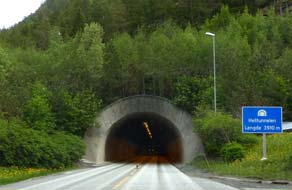 Photographic
disaster at Hell: in pouring rain the following morning, we re-joined
the E6 motorway heading north through the 4km long Hell Tunnel which emerges
close to Trondheim airport and a turning to the quaintly named rail junction and
village of Hell (meaning 'well-being' in Norwegian!). Unable to Photographic
disaster at Hell: in pouring rain the following morning, we re-joined
the E6 motorway heading north through the 4km long Hell Tunnel which emerges
close to Trondheim airport and a turning to the quaintly named rail junction and
village of Hell (meaning 'well-being' in Norwegian!). Unable to
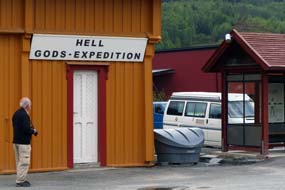 resist
the temptation to take a brief look at Hell, with the rain still pouring
we turned off and parked at the little station, with endless puns about the name
and Hellish weather. Just managing to get one photograph of the station sign
'Hell - gods expedition' (Hell - have a good journey), disaster
struck: Paul's camera lens jammed and no amount of turning or pushing would
shift it. That's what happens when you go to Hell and try to take photographs,
but wise cracks failed to fix the offending lens. The thought of facing the rest
of the trip sans camera was unthinkable, and it was fortunate we were still
within range of the city; there was nothing for it but to return to Vikhammer
Camping and ask advice from the professional photographer who shared the
premises about photographic shops in Trondheim. By 4-00pm we were back by bus
into Trondheim city centre at Japan Foto in Munke gata; the lens was beyond
repair and had to be replaced. We were back in business but the cost in
Norwegian kroner did not bear thinking about! After an unexpected extra night at
Vikhammer Camping, we returned to Hell in better weather the following morning
to re-photograph in better light the station with its punning sign-board, even recording the
times of trains to and from Hell. We could now say that we had been to Hell and
that it did not always rain there (see right). resist
the temptation to take a brief look at Hell, with the rain still pouring
we turned off and parked at the little station, with endless puns about the name
and Hellish weather. Just managing to get one photograph of the station sign
'Hell - gods expedition' (Hell - have a good journey), disaster
struck: Paul's camera lens jammed and no amount of turning or pushing would
shift it. That's what happens when you go to Hell and try to take photographs,
but wise cracks failed to fix the offending lens. The thought of facing the rest
of the trip sans camera was unthinkable, and it was fortunate we were still
within range of the city; there was nothing for it but to return to Vikhammer
Camping and ask advice from the professional photographer who shared the
premises about photographic shops in Trondheim. By 4-00pm we were back by bus
into Trondheim city centre at Japan Foto in Munke gata; the lens was beyond
repair and had to be replaced. We were back in business but the cost in
Norwegian kroner did not bear thinking about! After an unexpected extra night at
Vikhammer Camping, we returned to Hell in better weather the following morning
to re-photograph in better light the station with its punning sign-board, even recording the
times of trains to and from Hell. We could now say that we had been to Hell and
that it did not always rain there (see right).
We were both putting our
cameras to good use in photographing some of the characteristic flora
and fauna during these 2 weeks, and have included a
photo-gallery of
Flora & Fauna of NW Norway
Tirpitz anchorage at Fættenfjord: further north, E6 now a
narrow single-carriage road very busy with traffic descends to the insignificant
inlet of Fættenfjord, the innermost recess of Åsenfjord off Trondheim Fjord. The
German battleship Tirpitz, sister ship of Bismark, had hidden away
here during 1941~42 after her post-commissioning sea trials in the Baltic until
she was moved north to Kåfjord in March 1943.
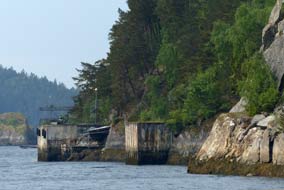 The
safe anchorage at Fættenfjord was protected from aerial attack by the
surrounding hills and from naval attacks by coastal gun emplacements. A constant
threat to Allied shipping, Tirpitz was continually observed by RAF photo
reconnaissance Spitfires. Bombing missions failed to make any impact since at
that time the RAF had no bombs big enough to pierce the battleship's armour
plating, and bomb-aiming techniques were insufficiently accurate, resulting in
major losses of aircraft and crews who were buried and commemorated at the CWGC
cemetery in Trondheim. The
safe anchorage at Fættenfjord was protected from aerial attack by the
surrounding hills and from naval attacks by coastal gun emplacements. A constant
threat to Allied shipping, Tirpitz was continually observed by RAF photo
reconnaissance Spitfires. Bombing missions failed to make any impact since at
that time the RAF had no bombs big enough to pierce the battleship's armour
plating, and bomb-aiming techniques were insufficiently accurate, resulting in
major losses of aircraft and crews who were buried and commemorated at the CWGC
cemetery in Trondheim.
A bizarre scheme was hatched up
to attack Tirpitz in her anchorage at Fættenfjord using 2-man human
torpedoes towed into Trondheim Fjord by the redoubtable Norwegian Resistance
activist Leif Larsen behind his fishing boat Arthur, with the
'Chariots' naval crews hidden in a secret compartment behind a cargo of peat. In
late October 1942 Operation Title was launched: Arthur sailed from
Shetland across the North Sea to Norway towing the 2 RN Chariots. Larsen managed
to bluff his way into the highly protected Trondheim Fjord and advanced to
within 16kms of Tirpitz in Fættenfjord, but the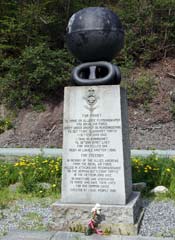 mission was dogged by misfortune: Arthur suffered several engine
failures, then when a storm brewed up both Chariots broke adrift from her
mountings under the Arthur's keel and sank in the fjord's deep waters.
The mission had to be aborted:
Arthur was scuttled and
Larsen, his 3 Norwegian crew and 6 Royal Navy divers and crew set off on foot
over the mountains. All managed to escape across the border into neutral Sweden,
except one British sailor, AB Evans who was wounded in a skirmish with a German
patrol and left to be taken POW. He was later executed by the Germans, one of
the war crimes cited against Dönitz at the 1945 Nuremberg Trials.
mission was dogged by misfortune: Arthur suffered several engine
failures, then when a storm brewed up both Chariots broke adrift from her
mountings under the Arthur's keel and sank in the fjord's deep waters.
The mission had to be aborted:
Arthur was scuttled and
Larsen, his 3 Norwegian crew and 6 Royal Navy divers and crew set off on foot
over the mountains. All managed to escape across the border into neutral Sweden,
except one British sailor, AB Evans who was wounded in a skirmish with a German
patrol and left to be taken POW. He was later executed by the Germans, one of
the war crimes cited against Dönitz at the 1945 Nuremberg Trials.
The E6 ran along the shoreline
of Fættenfjord opposite the low cliffs where Tirpitz had been anchored.
We turned off along a dirt track at the head of the fjord to find the memorial
set up by local people in 1985 to commemorate RAF bomber and reconnaissance
crews killed in 1942 missions against the battleship (see right) (Photo
18 - RAF Tirpitz attacks memorial at Fættenfjord). We stood at the dry end of
the fjord looking along under low cliffs to the concrete remains that had formed
Tirpitz's 1941~42 anchorage (see above left)
(Photo
19 - Tirpitz's 1941~42 anchorage at Fættenfjord). We photographed the memorial and followed the dirt
track steeply uphill above the fjord edge hoping this would give closer views of
Tirpitz's anchorage, but this led only to boathouses where one of the
contact mines that once protected Tirpitz was preserved. It would have
been poignant to have camped here so close to Tirpitz's 1942 anchorage,
but the little campsite at Fættenfjord was long closed and totally overgrown.
With the weather now gloomy and rain pouring, we therefore left the head of the
fjord, following E6 accompanied by the Bodø railway line steeply up a narrow
defile, and just beyond Åsen reached Gulberget Camping; at 190 NOK/night
including showers and wi-fi,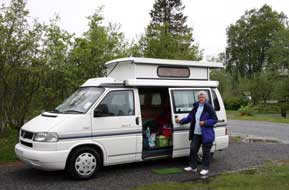 this was a hospitably welcoming campsite in such
wretched weather (see left); and the forecast was not much better for our onward northern
journey. this was a hospitably welcoming campsite in such
wretched weather (see left); and the forecast was not much better for our onward northern
journey.
Battle of Stiklestad - the significance of St Olaf for Norway:
continuing across broad, flat farming countryside, we passed Verdal a small
industrial town set at the innermost head of Trondheim Fjord and in the distance
could see the outline of shipyards which now fabricate rigs to support Norway's
North Sea oil and gas industry. Just beyond, we turned inland to find Stiklestad,
the legendary site of the battle on 29 July 1030 at which Olaf Haraldsson was
killed. His 15 year old half-brother Harald Sigurdsson survived the battle and
would go on in 1047 to become King of Norway, only to die at Stanford Bridge in
Harald Håråda's failed invasion of England. We wanted to learn something of the
complex military and religious power struggles of the late Viking Age which led
to the Battle of Stiklestad and his subsequently canonisation as St Olaf,
Norway's patron saint.
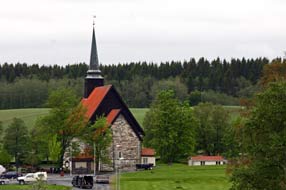 During the 9th century AD, Norway had been divided between several local Viking
chieftain-kings, each controlling their own petty fiefdom. Harald Fairhair (Hårfagri)
in military alliance with the Jarls of Lade in Trøndelag had managed to unify
the kingdom briefly, but after his death his descendents spent the 10th century
in warring power feuds. Religion also played a part in these power struggles as
Håkon the Good and Olaf Tryggvason attempted by bloody force to convert the
pagan Norwegians to Christianity. In 1015, Olaf Haraldsson, another of Harald
Fairhair's descendents who had converted to Christianity during his childhood
upbringing in England, returned to Norway to gain the kingdom. While his rival,
Knut the Great of Denmark, was preoccupied with wars in England, Olaf with a
peasant army secured the Norwegian throne. During his brief reign, Olaf with
Christianising zeal forced the new religion on his subjects with a regime of
brutal executions and torture, so alienating the major land-owning
classes such as Dale Gudbrand whom we had met at Hunsdorp in the valley of Gudbrandsdalen
that still bears his name. Olaf's hold on power lasted only until 1028: Knut in
alliance with the Jarls of Lade During the 9th century AD, Norway had been divided between several local Viking
chieftain-kings, each controlling their own petty fiefdom. Harald Fairhair (Hårfagri)
in military alliance with the Jarls of Lade in Trøndelag had managed to unify
the kingdom briefly, but after his death his descendents spent the 10th century
in warring power feuds. Religion also played a part in these power struggles as
Håkon the Good and Olaf Tryggvason attempted by bloody force to convert the
pagan Norwegians to Christianity. In 1015, Olaf Haraldsson, another of Harald
Fairhair's descendents who had converted to Christianity during his childhood
upbringing in England, returned to Norway to gain the kingdom. While his rival,
Knut the Great of Denmark, was preoccupied with wars in England, Olaf with a
peasant army secured the Norwegian throne. During his brief reign, Olaf with
Christianising zeal forced the new religion on his subjects with a regime of
brutal executions and torture, so alienating the major land-owning
classes such as Dale Gudbrand whom we had met at Hunsdorp in the valley of Gudbrandsdalen
that still bears his name. Olaf's hold on power lasted only until 1028: Knut in
alliance with the Jarls of Lade
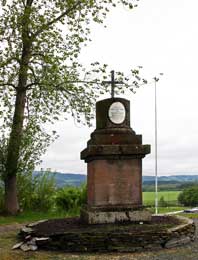 expelled him and Olaf fled to Sweden. He managed
to raise a small rag-tag army and re-crossed the mountains into the valley of Verdal in North Trøndelag to regain his throne. The Norwegian feudal landowners
backed by Knut met him with a larger army at Stiklestad on 29 July 1030, where
Olaf was killed in the battle. expelled him and Olaf fled to Sweden. He managed
to raise a small rag-tag army and re-crossed the mountains into the valley of Verdal in North Trøndelag to regain his throne. The Norwegian feudal landowners
backed by Knut met him with a larger army at Stiklestad on 29 July 1030, where
Olaf was killed in the battle.
In the subsequent power
struggles, the early Norse church needed all the support it could muster to
reinforce its hold on power. Olaf had been a brutally unsavoury character but
rumours of his uncorrupted body when his coffin was opened for re-burial was
sufficient grounds for sainthood along with his death in battle at Stiklestad construed as Christian martyrdom defending the beleaguered new
religion. The cult of St Olaf conveniently provided the struggling Church with
the perfect endorsement and legitimisation of its power - a God-sent Norwegian
saint. Brutal and divisive in life, Olaf in death as saint and Christian martyr
brought a unifying power to Norway: Olaf's illegitimate son Magnus forced Knut
to yield the Norwegian throne, so securing the kingdom for Christianity; Olaf
became Rex Perpetuus Norvegiae, bringing a century of prosperity and
expansion lasting until Norway again descended into internecine power struggles
in the 13th century, and finally fell under Danish domination. The Battle of
Stiklestad symbolised Norway's passage from a bloody Viking past into its
medieval future.
Our visit to Stiklestad:
6kms from E6 led through Verdal's industrial suburbs to what for Norwegians is
still a popular symbolic cult centre of national identity, and as such is fully
exploited by the modern mass tourism industry. Millions of kroner have been
spent on a grandiose National Cultural Centre with admission prices of 140NOk to
match. The surrounding area is laid out like a medieval theme park with
pseudo-Viking farmstead-skansen and, most sordid of all, a huge outdoor
amphitheatre where on each 29 July, St Olaf's Day and anniversary of the battle,
Norwegian flock in their 1000s, paying extortionate prices to see a tacky
dramatic re-enactment of events leading to Olaf's death in battle. Fortunately
this early in the summer, the site was almost deserted as we walked over to the Kulturhus-cum-conference hotel in the vain hope that we could gain information
without paying mega-kroner; all we got from the condescending receptionist was
an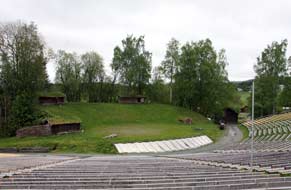 arrogant sneer when we declined to part with money for a site plan. arrogant sneer when we declined to part with money for a site plan.
We firstly walked over to the
dignified 12th century Stiklestad church under whose altar the stone on which
the dying Olaf leant is said to lay
(Photo
20 - 12th century church at Stiklestad); today this beautiful medieval church stands
with peaceful disdain towards all the nearby tacky commercial modernism (see
above right). Having
photographed the church in gloomy light from under its border of birch trees, we
ambled up the hillside to where the monument to Olaf's death in battle
erected in 1807 now stands rather forlornly on a hillock away from all the
razzmatazz; its inscription claims it as the oldest such memorial. During the
WW2 German occupation, the Quisling puppet regime it replaced with a Nazi
monolith; the old memorial was secretly removed and restored after the war, and
Quisling's replacement buried. In recent years there has been controversy about
restoring this one. We continued over to the amphitheatre which allegedly seats
5,500 spectators on its wooden benches around the natural auditorium with an
unlikely modern equestrian statue of the saintly hero presiding over all
(Photo
21 - Stiklestad natural amphitheatre).
Apparently Norway's leading actors vie for parts in the summer festival's
dramatic performances, along with local people as extras for the crowd scenes.
It all sounded tackier than the Eurovision Song Contest!
The Bølabua reindeer rock-engravings: after a night's camp at the
curiously named Soria Moria Camping, we resumed our northward
journey the following morning, reaching the small town of Steinkjer which is
set on the innermost reaches of Trondheim Fjord. The Germans bombed the town to
total destruction in 1940, and Steinkjer had to be rebuilt after the war. This
morning low cloud clung to the surrounding hills filling the air with fine misty
drizzle. Rather than continue up the monotonous E6, we turned off onto the
peaceful Route 763 which meanders along the southern shore of Lake Snåsavatnet through farmland and hills wooded with majestic pines and birches. The northern railway line runs parallel with the road on a precarious shelf
along the steep-sided lake-shore, and had been the target of Resistance sabotage
attacks in both 1940
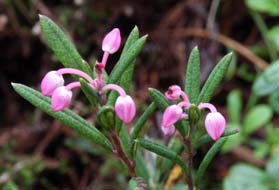 to delay the invading Germans northward advance, and again
in early 1945 to impede their retreat from Finmark; we passed several memorials
to these brave resistance fighters. Some 30kms along the lake, we reached
today's first objective, the rock engravings at Bølabua. Parking at the closed
café with its small, peaceful camping-aire (another spot we should have like to
camp had it been convenient to our route), and in gloomy light set off on the
sign-posted path. The engravings had been created some 4,000 years BC by
Neolithic peoples, traces of whose fjord-side dwellings had also been found.
With land levels lower at that time, Lake Snåsavatnet was still connected
directly to Trondheim Fjord. As we walked the 500m path leading to the
archaeological treasures of the petroglyphs, the pine forest floor showed its
own botanical gems: the low-lying, spiky-leaved plants of our dear old friend
Bog Rosemary with its beautiful tiny pink globular flowers, most still in
bud this early in the year, and we were soon down on hands and knees
photographing them; we then spotted tiny Chickweed Wintergreen also still in bud
and Wood Anemones, growing among the bright green new-leafed Bilberry plants
with their salmon-pink pendant flowers and the lingonberry whose flowers were
still in tight bud. We spent longer photographing this year's first major find
of northern flora, so familiar from our last 2 years' Scandinavian trips than we
did examining the rock-engravings. to delay the invading Germans northward advance, and again
in early 1945 to impede their retreat from Finmark; we passed several memorials
to these brave resistance fighters. Some 30kms along the lake, we reached
today's first objective, the rock engravings at Bølabua. Parking at the closed
café with its small, peaceful camping-aire (another spot we should have like to
camp had it been convenient to our route), and in gloomy light set off on the
sign-posted path. The engravings had been created some 4,000 years BC by
Neolithic peoples, traces of whose fjord-side dwellings had also been found.
With land levels lower at that time, Lake Snåsavatnet was still connected
directly to Trondheim Fjord. As we walked the 500m path leading to the
archaeological treasures of the petroglyphs, the pine forest floor showed its
own botanical gems: the low-lying, spiky-leaved plants of our dear old friend
Bog Rosemary with its beautiful tiny pink globular flowers, most still in
bud this early in the year, and we were soon down on hands and knees
photographing them; we then spotted tiny Chickweed Wintergreen also still in bud
and Wood Anemones, growing among the bright green new-leafed Bilberry plants
with their salmon-pink pendant flowers and the lingonberry whose flowers were
still in tight bud. We spent longer photographing this year's first major find
of northern flora, so familiar from our last 2 years' Scandinavian trips than we
did examining the rock-engravings.
Some 500m along the woodland path,
we found the life-sized outline of a reindeer engraved with flint tools onto
a high, sloping, water-smoothed rocky outcrop which provided perfect panels for
Neolithic artistic expression. This first petroglyph was the most distinctly
evident of the 4 ritualistic engravings at Bøla: the life-sized engraving of a
reindeer was a perfect, naturalistic masterpiece, engraved by a Neolithic
artist with a fine sense of form and beauty, and was remarkably 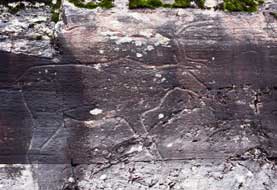 well-preserved, the angle of the rock catching the light even in poor visibility
(Photo
22 - Bølabua reindeer rock engraving). Water still
cascaded from a fast-flowing torrent over parts of the outcrop, making the next
engraving of a bear less evident and preserved due to repeated freezing
and thawing of flood water washing over the engraving. Lower down on a flat
slab, an information panel identified the position of the most distinctive of Bøla's rock-engravings, that of a skier. The chiselled groves making the
figure's outline were badly weathered making it difficult to identify: the man
is on skis with the engraving clearly showing the ski's bindings to his foot;
the figure holds a ski pole and adopts a body position exactly as a modern skier
would. He is depicted in natural size 148cms from the bottom edge of his ski to
the top of his head, another wonderfully naturalistic piece of artistic
expression. None of the Bøla engravings had been outlined with red paint as
elsewhere, which although making it less easy to identify them, at least
conserved their natural state. And the setting of the rock panels was equally
impressive beside roaring cascades amid pine forests, next to the curving
embankment of the railway line with its magnificent stone bridge arching 13m
over the torrent. It was during the construction of the railway line in 1926
that the engravings had been discovered. Today had been another dual interest
day of both historical and floral treasures in this lovely forest setting. But
we also experienced this morning the first signs of another coming summer menace
- the dreaded midges, hovering around our faces as we attempted to take
photographs. well-preserved, the angle of the rock catching the light even in poor visibility
(Photo
22 - Bølabua reindeer rock engraving). Water still
cascaded from a fast-flowing torrent over parts of the outcrop, making the next
engraving of a bear less evident and preserved due to repeated freezing
and thawing of flood water washing over the engraving. Lower down on a flat
slab, an information panel identified the position of the most distinctive of Bøla's rock-engravings, that of a skier. The chiselled groves making the
figure's outline were badly weathered making it difficult to identify: the man
is on skis with the engraving clearly showing the ski's bindings to his foot;
the figure holds a ski pole and adopts a body position exactly as a modern skier
would. He is depicted in natural size 148cms from the bottom edge of his ski to
the top of his head, another wonderfully naturalistic piece of artistic
expression. None of the Bøla engravings had been outlined with red paint as
elsewhere, which although making it less easy to identify them, at least
conserved their natural state. And the setting of the rock panels was equally
impressive beside roaring cascades amid pine forests, next to the curving
embankment of the railway line with its magnificent stone bridge arching 13m
over the torrent. It was during the construction of the railway line in 1926
that the engravings had been discovered. Today had been another dual interest
day of both historical and floral treasures in this lovely forest setting. But
we also experienced this morning the first signs of another coming summer menace
- the dreaded midges, hovering around our faces as we attempted to take
photographs.
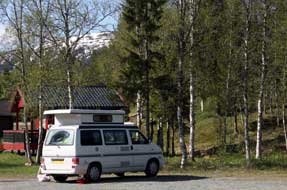 The E6 road north through Nord
Trøndelag and welcoming Nyheim Camping: re-joining E6 near the village
of Snåsa with misty low cloud now wafting across the lake, we turned north on a
good road rising through impressively hilly terrain, and descended to the road
junction at Grong. The road west went to Namsos, and eastward Route 74 headed
towards the Swedish border-crossing to Gäddede on the Wilderness Road where we
had camped last year. We continued north on E6 which now became narrow and
winding following the valley of Namdalen and the fast-flowing River Namsen. The
forested hilly terrain opened out to give broad, spectacular vistas of distant
snow-covered mountains giving a real feeling of truly moving north. But we still
had some distance to drive to reach tonight's campsite near to the county border
between North Trøndelag and Nordland, and there was little chance to stop and
admire the frequent series of river rapids. Just beyond Namskogen, we reached
Nyheim Camping, a small campsite with just 30 places and huts ranged along the
riverside set on a terrace wedged between the E6 and the now broad and The E6 road north through Nord
Trøndelag and welcoming Nyheim Camping: re-joining E6 near the village
of Snåsa with misty low cloud now wafting across the lake, we turned north on a
good road rising through impressively hilly terrain, and descended to the road
junction at Grong. The road west went to Namsos, and eastward Route 74 headed
towards the Swedish border-crossing to Gäddede on the Wilderness Road where we
had camped last year. We continued north on E6 which now became narrow and
winding following the valley of Namdalen and the fast-flowing River Namsen. The
forested hilly terrain opened out to give broad, spectacular vistas of distant
snow-covered mountains giving a real feeling of truly moving north. But we still
had some distance to drive to reach tonight's campsite near to the county border
between North Trøndelag and Nordland, and there was little chance to stop and
admire the frequent series of river rapids. Just beyond Namskogen, we reached
Nyheim Camping, a small campsite with just 30 places and huts ranged along the
riverside set on a terrace wedged between the E6 and the now broad and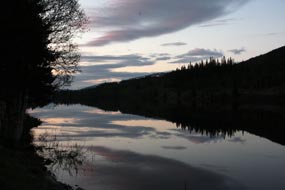 more
peacefully-flowing River Namsen (see left). The lady-owner saw us arrive and welcomed us
with quiet hospitality, volunteering a discounted early season price of just 200
NOK including showers and site-side wi-fi. Several of the huts were already
occupied, the E6 providing a regular passing trade at this early time of the
year. The air was really chill as we settled in, but the highly reliable Norway's Meteorological Institute weather forecast
showed an improving prospect for the coming days. Although
a dull evening, as we came further north there was now no period of darkness;
although the sun set for a few hours between 11-00pm and 2-00am, it remained
light all night. Nyheim Camping with its hospitable welcome, recently upgraded
facilities and lovely setting on the banks of the quietly flowing wide River
Namsen was a perfect place for a day in camp to catch up with mundane jobs and
web-writing. And by late evening as the sky had finally cleared, it was as if
the river's flow had been turned off for the night: the ruddy glow of late
setting sun, and silhouetted reflections of riverbank trees and surrounding
snow-covered mountains were reflected in the perfectly still waters of the wide
river (see right). more
peacefully-flowing River Namsen (see left). The lady-owner saw us arrive and welcomed us
with quiet hospitality, volunteering a discounted early season price of just 200
NOK including showers and site-side wi-fi. Several of the huts were already
occupied, the E6 providing a regular passing trade at this early time of the
year. The air was really chill as we settled in, but the highly reliable Norway's Meteorological Institute weather forecast
showed an improving prospect for the coming days. Although
a dull evening, as we came further north there was now no period of darkness;
although the sun set for a few hours between 11-00pm and 2-00am, it remained
light all night. Nyheim Camping with its hospitable welcome, recently upgraded
facilities and lovely setting on the banks of the quietly flowing wide River
Namsen was a perfect place for a day in camp to catch up with mundane jobs and
web-writing. And by late evening as the sky had finally cleared, it was as if
the river's flow had been turned off for the night: the ruddy glow of late
setting sun, and silhouetted reflections of riverbank trees and surrounding
snow-covered mountains were reflected in the perfectly still waters of the wide
river (see right).
E6 north past Lakforsen
waterfalls to Mosjøen: the following morning in bright sunshine we
resumed our ever-northward journey, with the E6 generally a good if sometimes
winding single-carriage road initially running alongside the fast-flowing River
Namsen amid magnificent
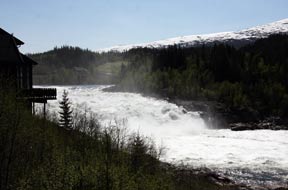 mountain terrain. Pine woods lit by morning sun and
wispy birches scarcely in leaf-bud this far north covered the lower hill slopes,
and distant higher snow-covered mountain peaks surrounded us. We passed the
occasional hill farm and the Tine milk-tanker collecting their morning dairy
production, and soon after crossed into the county of Nordland under an arched
sign announcing 'Gateway to the North'. This highpoint marked the watershed
between the south-flowing Namsen River and northward-flowing Vefsna which
entered the sea-fjord at Mosjøen. The road continued over a bleak mountain
plateau , passing a series of swollen river-lakes which reflected the vivid blue
of the clear sky against the backdrop of snow-covered mountains; it was a
glorious landscape. Just beyond the village of Sveningdal, we paused to
photograph our first reindeer this year, a small herd of trim-looking animals
grazing by the roadside. At Trofors, Route 73 branched off eastwards towards
Tärnaby and Hemavan, and just
beyond the farming village of Grane, we turned off to the Lakforsen Waterfalls,
where the broad River Vafsna drops 16m in foaming rapids (Photo
23 - Lakforsen Waterfalls). The name meaning
'Salmon Falls' indicates that in season, the salmon leap up the falls to reach
their spawning grounds. The lane led down to a café-souvenir shop immediately
alongside the falls, with a large car park to attract the droves of summer
tour-buses. We ignored this sordidly over-commercialised tourist trap and walked
down the road for the more mountain terrain. Pine woods lit by morning sun and
wispy birches scarcely in leaf-bud this far north covered the lower hill slopes,
and distant higher snow-covered mountain peaks surrounded us. We passed the
occasional hill farm and the Tine milk-tanker collecting their morning dairy
production, and soon after crossed into the county of Nordland under an arched
sign announcing 'Gateway to the North'. This highpoint marked the watershed
between the south-flowing Namsen River and northward-flowing Vefsna which
entered the sea-fjord at Mosjøen. The road continued over a bleak mountain
plateau , passing a series of swollen river-lakes which reflected the vivid blue
of the clear sky against the backdrop of snow-covered mountains; it was a
glorious landscape. Just beyond the village of Sveningdal, we paused to
photograph our first reindeer this year, a small herd of trim-looking animals
grazing by the roadside. At Trofors, Route 73 branched off eastwards towards
Tärnaby and Hemavan, and just
beyond the farming village of Grane, we turned off to the Lakforsen Waterfalls,
where the broad River Vafsna drops 16m in foaming rapids (Photo
23 - Lakforsen Waterfalls). The name meaning
'Salmon Falls' indicates that in season, the salmon leap up the falls to reach
their spawning grounds. The lane led down to a café-souvenir shop immediately
alongside the falls, with a large car park to attract the droves of summer
tour-buses. We ignored this sordidly over-commercialised tourist trap and walked
down the road for the more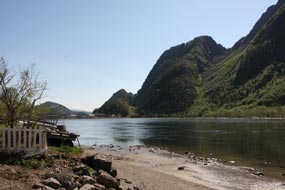 spectacular view looking up the river along
the
length of the surging cascades, before resuming our northward drive towards Mosjøen. spectacular view looking up the river along
the
length of the surging cascades, before resuming our northward drive towards Mosjøen.
Excellent VW service:
driving north, we had earlier clashed
George's near-side wing-mirror with an on-coming vehicle on a narrow bridge
cracking the glass; before leaving Nyheim Camping, we used the campsite wi-fi to
find details of VW agents in Mosjøen, Mo-i-Rana, Bodø and Tromsø, and telephoned
ahead to the first of these towns to arrange to call in in the hope of fitting a replacement glass.
Approaching the town outskirts, we turned off to find Hansens Bilversted the Mosjøen
VW agent, but the issue of replacing the wing-mirror glass was not as
straightforward as believed: the near-and off-side wing mirrors were of
different shapes, and being British right-hand drive, George's were handed
compared with Norwegian left-hand drive. The new part would have to be shipped
from Germany and would take a week to deliver. As always however, the VW garage
staff could not have been more helpful and immediately came up with a solution:
he looked up the exact part
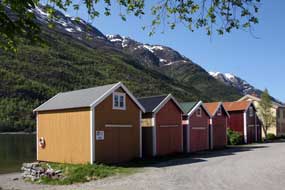 number and suggested phoning ahead to the Tromsø VW
agent on our behalf, asking them to order the part for us in readiness for
fitting when we passed through Tromsø in 6 weeks time on our northward journey.
The part was duly ordered to await our arrival for fitting. How's that for
superb VW service, experienced consistently all across Europe! And as an added
bonus to all this help, the garage staff tutored us in how to pronounce Mosjøen
- more like Moosh-ern. number and suggested phoning ahead to the Tromsø VW
agent on our behalf, asking them to order the part for us in readiness for
fitting when we passed through Tromsø in 6 weeks time on our northward journey.
The part was duly ordered to await our arrival for fitting. How's that for
superb VW service, experienced consistently all across Europe! And as an added
bonus to all this help, the garage staff tutored us in how to pronounce Mosjøen
- more like Moosh-ern.
Our visit to Mosjøen:
with this solution to the cracked wing-mirror problem in place, and with thanks
for such superb service, we drove into the centre of the small town of Mosjøen,
set at the end of its fjord and overwhelmed by snow-covered mountains (see above
right). Mosjøen
had long been a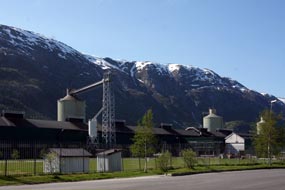 small-time trading settlement wedged between outflow of the
River Vefsna into the fjord and the surrounding mountains. But in the 1960s, a
huge aluminium smelting plant was built here, dominating the northern side of
the fjord-side town and providing much-needed employment (see right). We parked by the town
centre and walked along the river-side to photograph the attractive wooden
houses and colourfully painted small wooden warehouses of Sjøgata (see left) (Photo
24 - Fjord-side wooden warehouses at Mosjøen). Their
original functionality was long gone and most were now converted to twee
'ateliers' or arty-farty souvenir shops. It was however a very attractive
setting, and local youngsters sun-bathed and children played along the
river shore in the Spring sunshine. At the far end of Sjøgata we found the TIC,
where the patient lass rehearsed with us our pronunciation of Mosjøen, and
looking across the fjord we photographed the not-unattractive aluminium plant
and its mountainous backdrop. After stocking up with provisions at the Rimi
supermarket, we continued north on E6. small-time trading settlement wedged between outflow of the
River Vefsna into the fjord and the surrounding mountains. But in the 1960s, a
huge aluminium smelting plant was built here, dominating the northern side of
the fjord-side town and providing much-needed employment (see right). We parked by the town
centre and walked along the river-side to photograph the attractive wooden
houses and colourfully painted small wooden warehouses of Sjøgata (see left) (Photo
24 - Fjord-side wooden warehouses at Mosjøen). Their
original functionality was long gone and most were now converted to twee
'ateliers' or arty-farty souvenir shops. It was however a very attractive
setting, and local youngsters sun-bathed and children played along the
river shore in the Spring sunshine. At the far end of Sjøgata we found the TIC,
where the patient lass rehearsed with us our pronunciation of Mosjøen, and
looking across the fjord we photographed the not-unattractive aluminium plant
and its mountainous backdrop. After stocking up with provisions at the Rimi
supermarket, we continued north on E6.
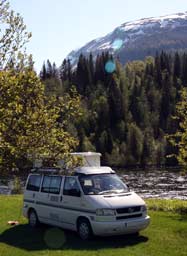 Another superbly located
campsite, Korgen Camping: across farming hill-land, E6 passed
exquisitely blue lakes backed by spectacular mountain peaks to reach the
entrance to the newly engineered Korgfjell Tunnel which bores 8.6 kms through
the high fells immediately south of Korgen. Emerging from the north portal, we
turned off into the village, and some 800m beyond on the grassy banks of the
River Røssåga, we reached Korgen Camping. The lady-owner had returned our
telephone enquiry late last evening, and welcomed us hospitably. The campsite
was largely deserted at this time of year, and in warm afternoon sunshine we
pitched on the lush grass of the river bank. The fast-flowing waters swished and
gurgled around a Another superbly located
campsite, Korgen Camping: across farming hill-land, E6 passed
exquisitely blue lakes backed by spectacular mountain peaks to reach the
entrance to the newly engineered Korgfjell Tunnel which bores 8.6 kms through
the high fells immediately south of Korgen. Emerging from the north portal, we
turned off into the village, and some 800m beyond on the grassy banks of the
River Røssåga, we reached Korgen Camping. The lady-owner had returned our
telephone enquiry late last evening, and welcomed us hospitably. The campsite
was largely deserted at this time of year, and in warm afternoon sunshine we
pitched on the lush grass of the river bank. The fast-flowing waters swished and
gurgled around a river-island overshadowed by the pine-covered hill opposite
whose snow-capped craggy peak peeped out from above the tree-line. In weather
like this, it was a gloriously peaceful spot to camp (see left). And the bird-life along
the river was equally appealing: Golden Eye ducks, the male performing his
peculiar cocking-his-head-back courtship display, a pair of Red Breasted
Mergansers with their long orange bill, and small podgy Common Sandpiper flying
fast and low along the river or wading in the shallows. The sun continued late
but the evening grew chill; as we neared the Arctic Circle just north of Mo-i-Rana,
the sun scarcely set now. river-island overshadowed by the pine-covered hill opposite
whose snow-capped craggy peak peeped out from above the tree-line. In weather
like this, it was a gloriously peaceful spot to camp (see left). And the bird-life along
the river was equally appealing: Golden Eye ducks, the male performing his
peculiar cocking-his-head-back courtship display, a pair of Red Breasted
Mergansers with their long orange bill, and small podgy Common Sandpiper flying
fast and low along the river or wading in the shallows. The sun continued late
but the evening grew chill; as we neared the Arctic Circle just north of Mo-i-Rana,
the sun scarcely set now.
We woke to another warm, sunny
morning and for the first time this trip were able to breakfast outside on the
grassy river bank, to the accompaniment of birdsong and the gurgling river
rushing by; it was a truly beautiful setting, but the problem with relaxing in
the sunshine was that time passes quickly and it was noon by the time we were
away. In the upper part of Korgen village, we found the memorial topped
with the communist red star to the 100s of Yugoslav POWs who had been worked or
starved to death as slave labour by the barbaric Germans in WW2 building the
road over Korgfjell. An information panel gave details of the prison camp here
at Korgen. The high vantage point on the hillside gave a magnificent panorama
across the Røssåga valley with our riverside campsite, Korgen village spread out
below, and the surrounding circle of pine-forested fells and snow-covered
mountain peaks; it was a glorious scene (Photo
25 - Korgen village). The river flows just a short distance
from the now dammed Røssvatnet, powering 2 HEP generating near Korgen
plants, on its way to flow into Sørfjord near to Mo-i-Rana.
 A visit to Mo-i-Rana: with the railway running parallel the narrow
E6 road wound around headlands northwards along the south shore of Ranafjord
towards Mo-i-Rana which nestles at the head of the fjord hemmed in by snowy
mountains. Reaching the centre, we parked by the Tourist Information Centre for
a town plan and details of what we should see in Mo-i-Rana. Once a market town
and port, Mo had been destroyed by German bombing in 1940 and re-built after
WW2. The post-war Norwegian Labour government transformed Mo by building a huge
steel plant in the town to help boost the economy of the devastated northern
parts of the country. The town grew in size with the steel plant as the mainstay
of its expanding economy employing 1000 workers. The economic decline of the
late 1980s however caused the plant's closure, the loss of employment being A visit to Mo-i-Rana: with the railway running parallel the narrow
E6 road wound around headlands northwards along the south shore of Ranafjord
towards Mo-i-Rana which nestles at the head of the fjord hemmed in by snowy
mountains. Reaching the centre, we parked by the Tourist Information Centre for
a town plan and details of what we should see in Mo-i-Rana. Once a market town
and port, Mo had been destroyed by German bombing in 1940 and re-built after
WW2. The post-war Norwegian Labour government transformed Mo by building a huge
steel plant in the town to help boost the economy of the devastated northern
parts of the country. The town grew in size with the steel plant as the mainstay
of its expanding economy employing 1000 workers. The economic decline of the
late 1980s however caused the plant's closure, the loss of employment being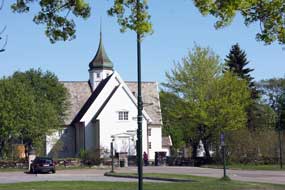 a
savage economic blow to Mo-i-Rana, but government aid encouraged its replacement
with smaller scale high-tech industry. a
savage economic blow to Mo-i-Rana, but government aid encouraged its replacement
with smaller scale high-tech industry.
Having got our bearings, we walked
through an underpass at Mo's circular railway station building, past
pastel-shade painted wooden houses down to the fjord shore-side. Trying to avoid
seeing the ugly and incongruous Anthony Gormley's chunk of rock which
passed for a statue of Havmann (Man of the Sea), we looked across to the distant
dock cranes across the still waters of the fjord (see left). Nearby on the headland stood a
tragic memorial to a local girl, one of the 70 teenagers who had been murdered
at the Labour camp on the island of Utøya in July 2011 by Anders Breivik
the lunatic terrorist. We followed a pathway around the shore-line leading to
the conserved group of 19th century brightly painted wooden cottages on the
headland of Moholmen,
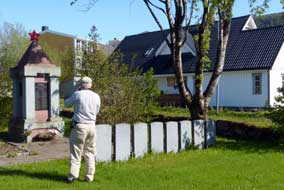 taking photographs in the bright morning sunshine as we
ambled around the little headland's 2 lanes between the cottages (Photo
26 - Moholmen wooden cottages). Returning to
the station as a freight train trundled past on its way north to Bodø, we
continued up the quiet pedestrianised stepped main street of Jernbarnegata,
pleasantly planted with birch trees, where local people went about their
business and children walked from school (Photo
27 - Jernbarnegata, Mo-i-Rana's main street). At the top of the hill by the Rana
Rådhus, we turned along to Mo church with its high pitched roof and onion dome
(see above right),
and searched the grave yard for the WW2 war cemetery. In a far corner we found a
small separate group of graves, with a 1945 memorial topped by a red star with a
list of names in Cyrillic script and communal grave of Russian POWs worked to
death so far from home as slave labour building the Arctic road and railway. And
alongside in an ordered row were the graves of 7 Scots Guards and 1 Royal
Artillery gunner killed in May 1940 trying to stem the German advance north (see
left) (Photo
28 - British war graves at Mo-i-Rana). The
headstones were of dark local stone, not the usual white CWGC white limestone.
We paid our respects and walked back down through the town. We liked Mo-i-Rana
as a surprisingly pleasant town, struggling to revive itself despite the closure
of its steelworks major employer. taking photographs in the bright morning sunshine as we
ambled around the little headland's 2 lanes between the cottages (Photo
26 - Moholmen wooden cottages). Returning to
the station as a freight train trundled past on its way north to Bodø, we
continued up the quiet pedestrianised stepped main street of Jernbarnegata,
pleasantly planted with birch trees, where local people went about their
business and children walked from school (Photo
27 - Jernbarnegata, Mo-i-Rana's main street). At the top of the hill by the Rana
Rådhus, we turned along to Mo church with its high pitched roof and onion dome
(see above right),
and searched the grave yard for the WW2 war cemetery. In a far corner we found a
small separate group of graves, with a 1945 memorial topped by a red star with a
list of names in Cyrillic script and communal grave of Russian POWs worked to
death so far from home as slave labour building the Arctic road and railway. And
alongside in an ordered row were the graves of 7 Scots Guards and 1 Royal
Artillery gunner killed in May 1940 trying to stem the German advance north (see
left) (Photo
28 - British war graves at Mo-i-Rana). The
headstones were of dark local stone, not the usual white CWGC white limestone.
We paid our respects and walked back down through the town. We liked Mo-i-Rana
as a surprisingly pleasant town, struggling to revive itself despite the closure
of its steelworks major employer.
 Elvmøthei Fjellgård
mountain-farm camp: re-joining E6, in the northern outskirts of Mo we
passed the now long-dead steel-works tucked into the hillside where the River
Tverråga cascaded down a side-valley over waterfalls. At the road junction where
the E12 'Blå Vägen' (Blue Road) cross-country highway came in from Tärnaby and
Storumen in Sweden that we had driven last year, we continued north on E6 now a
narrow road winding around headlands above the valley of the River Ranelva which
flows down into Ranafjord at Mo. Despite the spectacular pine and spruce
forested mountain scenery and snow-covered peaks, intolerantly speeding local
traffic made this a stressful drive. With the railway running parallel and
crossing the river gorge on huge trellis bridges, the road turned every
which way, with the high snowy fells of Saltfjell looming ahead. After a
wearying drive, we eventually reached the turning for the farmstead of Elvmøthei Fjellgård
where we should camp tonight. Crossing a narrow bridge over a foaming torrent
running down from Saltfjell's snow heights, we settled into the small camping
area among the pines beyond the farmhouse. There were a few statics but the eye
was drawn to the surrounding panorama of snow-capped mountains and the air
filled with the roar of the river torrent (see right). While the air was still warm, we
walked back to photograph the river surging torrent and the waterfalls tumbling from
Saltfjell (Photo
29 - River torrent at Elvmøthei Fjellgård), but as the sun dipped towards the mountain skyline, although still
bright, the evening began to grow chill. Elvmøthei Fjellgård
mountain-farm camp: re-joining E6, in the northern outskirts of Mo we
passed the now long-dead steel-works tucked into the hillside where the River
Tverråga cascaded down a side-valley over waterfalls. At the road junction where
the E12 'Blå Vägen' (Blue Road) cross-country highway came in from Tärnaby and
Storumen in Sweden that we had driven last year, we continued north on E6 now a
narrow road winding around headlands above the valley of the River Ranelva which
flows down into Ranafjord at Mo. Despite the spectacular pine and spruce
forested mountain scenery and snow-covered peaks, intolerantly speeding local
traffic made this a stressful drive. With the railway running parallel and
crossing the river gorge on huge trellis bridges, the road turned every
which way, with the high snowy fells of Saltfjell looming ahead. After a
wearying drive, we eventually reached the turning for the farmstead of Elvmøthei Fjellgård
where we should camp tonight. Crossing a narrow bridge over a foaming torrent
running down from Saltfjell's snow heights, we settled into the small camping
area among the pines beyond the farmhouse. There were a few statics but the eye
was drawn to the surrounding panorama of snow-capped mountains and the air
filled with the roar of the river torrent (see right). While the air was still warm, we
walked back to photograph the river surging torrent and the waterfalls tumbling from
Saltfjell (Photo
29 - River torrent at Elvmøthei Fjellgård), but as the sun dipped towards the mountain skyline, although still
bright, the evening began to grow chill.
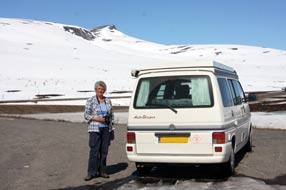 Crossing the Arctic Circle on the snowy wastes of Saltfjell: the
following morning, we began the long climb up onto the high Saltfjell plateau.
As we steadily gained height, pines and spruce gave way to wispy birches which
became increasingly stunted finally giving way to bare snow-covered tundra. Crossing the Arctic Circle on the snowy wastes of Saltfjell: the
following morning, we began the long climb up onto the high Saltfjell plateau.
As we steadily gained height, pines and spruce gave way to wispy birches which
became increasingly stunted finally giving way to bare snow-covered tundra.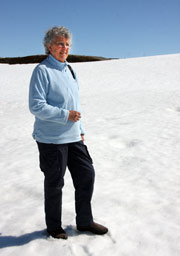 On a
bright sunny morning, it was a beautiful prospect, but in dull weather and poor
light it would have been an inhospitably bleak setting. The gradient eased as we
gained the wide open vista of the broad Saltfjell plateau, with snow-fields
stretching away to distant horizons of snow-covered peaks lit by a bright sun
against a blue sky. Several times we stopped to photograph this magnificent
Arctic panorama. We passed the 'bomstasjon' with its parking area and waiting
room where in winter drivers wait to be escorted in convoy behind the snow
plough across the exposed plateau top. Around this point E6 comes closest to the
Swedish border passing within 4 kms across the snow-covered wilderness. As we
neared the magic line of latitude at 66° 33' North, we paused at a lay-by for a
photograph of this our 3rd 'crossing of the line' (see left)
(Photo
30 - 66° 33' North - crossing Arctic Circle ); unlike the 2 previous
occasions at Oulanka in Finland and Jokkmokk in Sweden, this year on Norway's
high Saltfjell the snow-covered tundra gave the Arctic Circle a truly polar
feel (see right). We pulled into the parking area of the Arctic Circle Centre and a glance
inside showed just how much of a tacky, over-commercialised tourist trap it
really was. Outside amid the snow fields, 2 monuments commemorated the many
Yugoslav and Russian POWs who had died under the brutality of WW2 German slave
labour building the road over Saltfjell (see below left). On a
bright sunny morning, it was a beautiful prospect, but in dull weather and poor
light it would have been an inhospitably bleak setting. The gradient eased as we
gained the wide open vista of the broad Saltfjell plateau, with snow-fields
stretching away to distant horizons of snow-covered peaks lit by a bright sun
against a blue sky. Several times we stopped to photograph this magnificent
Arctic panorama. We passed the 'bomstasjon' with its parking area and waiting
room where in winter drivers wait to be escorted in convoy behind the snow
plough across the exposed plateau top. Around this point E6 comes closest to the
Swedish border passing within 4 kms across the snow-covered wilderness. As we
neared the magic line of latitude at 66° 33' North, we paused at a lay-by for a
photograph of this our 3rd 'crossing of the line' (see left)
(Photo
30 - 66° 33' North - crossing Arctic Circle ); unlike the 2 previous
occasions at Oulanka in Finland and Jokkmokk in Sweden, this year on Norway's
high Saltfjell the snow-covered tundra gave the Arctic Circle a truly polar
feel (see right). We pulled into the parking area of the Arctic Circle Centre and a glance
inside showed just how much of a tacky, over-commercialised tourist trap it
really was. Outside amid the snow fields, 2 monuments commemorated the many
Yugoslav and Russian POWs who had died under the brutality of WW2 German slave
labour building the road over Saltfjell (see below left).
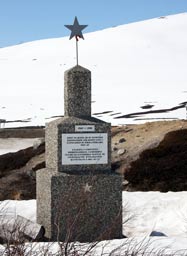 E6 continued across Saltfjell's
snowy tundra wilderness with its mountainous skyline, and we passed the road's Høgeste Punkt (highest point) at 692m above sea level
(see below right). Remarkably the modern
successor to the Arctic railway constructed by Slav POW slave labourers in WW2 still
crosses the plateau-top running parallel with the road. Just beyond the high
point, the northern railway line to Bodø crossed under E6 on a sweeping arched bridge, cutting a
straight line on a raised embankment clear above the snow-fields (Photo
31 - Railway line across Saltfjell's snowy tundra). As E6 began
gradually to loose height, the snow-fields became thinner giving way to marshy
tundra on the flat northern side of the plateau watershed. The road's descent
soon began to steepen, crossing below the tree-line to meet the zone of
bare-branched birches and passing Sámi hut settlements with their reindeer
fencing. The gradient steepened further with the narrow road following the
cascading torrent of the Lønselva watercourse and carving out a rocky gorge.
Birches gave way to denser E6 continued across Saltfjell's
snowy tundra wilderness with its mountainous skyline, and we passed the road's Høgeste Punkt (highest point) at 692m above sea level
(see below right). Remarkably the modern
successor to the Arctic railway constructed by Slav POW slave labourers in WW2 still
crosses the plateau-top running parallel with the road. Just beyond the high
point, the northern railway line to Bodø crossed under E6 on a sweeping arched bridge, cutting a
straight line on a raised embankment clear above the snow-fields (Photo
31 - Railway line across Saltfjell's snowy tundra). As E6 began
gradually to loose height, the snow-fields became thinner giving way to marshy
tundra on the flat northern side of the plateau watershed. The road's descent
soon began to steepen, crossing below the tree-line to meet the zone of
bare-branched birches and passing Sámi hut settlements with their reindeer
fencing. The gradient steepened further with the narrow road following the
cascading torrent of the Lønselva watercourse and carving out a rocky gorge.
Birches gave way to denser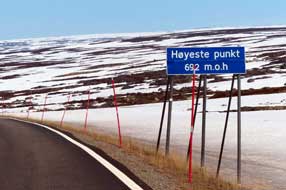 woodland of pine and spruce as we wound steeply down
to pass the junction of Route 77. This road turned off eastwards to the Swedish
border to become the 'Silver Road' to Areplog, Ardvidsjaur and eventually
Skellefteå on the Bothnian coast, another world away. woodland of pine and spruce as we wound steeply down
to pass the junction of Route 77. This road turned off eastwards to the Swedish
border to become the 'Silver Road' to Areplog, Ardvidsjaur and eventually
Skellefteå on the Bothnian coast, another world away.
The 'Blood Road' and Yugoslav
POW-slave labour war cemeteries at Rognan and Botn: in total contrast
to the snowy barren tundra wastes of Saltfjell, the lengthy valley of Saltdalen
was a lush, green paradise, the birches here in full leaf with the wide Saltelva
river flowing peacefully along the broad valley which was hemmed in on both
sides by high fells. Farms crowded the valley bottom with ploughed fields and
grazing sheep and cattle. In bright afternoon sunshine, we drove the length of
the valley reaching the inner recesses of Saltdalsfjord and crossing the river
to the village of Rognan. By the fjord-side we found the Blood Road Museum
housed in an original WW2 German barrack hut from the huge POW slave labour camps
here at Saltdal and Botn. Some 30,000 Russian, Serbian and Polish POWs were
transported to North Norway to work on improving the state highway and advancing
the railway north from Mosjøen. They were housed in appalling conditions in
prison camps with totally inadequate clothing against
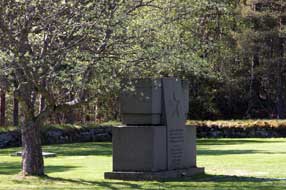 the severe winter climate,
and subjected to malnutrition and brutal treatment by SS guards. The worst
brutalities were however inflicted by young Norwegian SS volunteers; one
Norwegian civilian road worker spoke of the treatment by fellow Norwegians
towards Serbian POWs he had witnessed at Botn as beyond belief. The Blood Road
Museum documents the brutality towards Slavic POW-slave labourers, but it was
closed with today being a public holiday. We had however established the
location of war cemeteries (Krigskirkegårder) above Botn and followed the 'Blood
Road' steeply up into the wooded hills. The lane ended at 2 separate cemeteries,
the first being the burial place of 1,657 of the 2,368 Yugoslav POWs who died in
Northern Norway (see left). Even on a sunny afternoon, this wooded glade was a movingly
mournful place with the graveyard enclosed by mossy stone walls and turf
immaculately maintained (Photo
32 - Yugoslav POW~slave labour war cemetery at Botn). Individual and communal grave-plaques listed the names
of the poor men who died here from disease, hypothermia, malnutrition as well as
sheer bloody barbaric German brutality, torture and mass executions. In
contrast, the other cemetery contained the graves of 2,732 of their German
captors who died in the district during WW2, and a memorial to the 2,000 German
sailors drowned when the Scharnhorst was sunk off Nordkapp in December
1943. The graves were marked by granite crosses with a offensively monstrous
Teutonic cross in the graveyard's centre. the severe winter climate,
and subjected to malnutrition and brutal treatment by SS guards. The worst
brutalities were however inflicted by young Norwegian SS volunteers; one
Norwegian civilian road worker spoke of the treatment by fellow Norwegians
towards Serbian POWs he had witnessed at Botn as beyond belief. The Blood Road
Museum documents the brutality towards Slavic POW-slave labourers, but it was
closed with today being a public holiday. We had however established the
location of war cemeteries (Krigskirkegårder) above Botn and followed the 'Blood
Road' steeply up into the wooded hills. The lane ended at 2 separate cemeteries,
the first being the burial place of 1,657 of the 2,368 Yugoslav POWs who died in
Northern Norway (see left). Even on a sunny afternoon, this wooded glade was a movingly
mournful place with the graveyard enclosed by mossy stone walls and turf
immaculately maintained (Photo
32 - Yugoslav POW~slave labour war cemetery at Botn). Individual and communal grave-plaques listed the names
of the poor men who died here from disease, hypothermia, malnutrition as well as
sheer bloody barbaric German brutality, torture and mass executions. In
contrast, the other cemetery contained the graves of 2,732 of their German
captors who died in the district during WW2, and a memorial to the 2,000 German
sailors drowned when the Scharnhorst was sunk off Nordkapp in December
1943. The graves were marked by granite crosses with a offensively monstrous
Teutonic cross in the graveyard's centre.
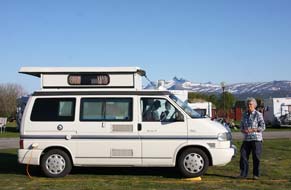 The road to Fauske and Bodøsjøen
Camping, Bodø:
back down the lane, we re-joined E6 which burrowed through short tunnels through
headlands and gained height in spectacular fashion around a high shelf above
Saltfjord to drop down towards Fauske. Fauske is a former copper and iron mining
town and cradle of Norwegian trade-unionism; it is also famous for its
Norwegian Rose marble quarried around the town and used to face such monumental
buildings as the Oslo Rådhus, UN Headquarters in New York and Emperor's Palace
in Tokyo. The modern town seemed pleasant but un-noteworthy, set on the
fjord-side at the road junction where E6 branches off north; we continued
westwards on Route 80 for the remaining 50kms to Bodø, winding along the shore
of Skjerstadfjord and following The road to Fauske and Bodøsjøen
Camping, Bodø:
back down the lane, we re-joined E6 which burrowed through short tunnels through
headlands and gained height in spectacular fashion around a high shelf above
Saltfjord to drop down towards Fauske. Fauske is a former copper and iron mining
town and cradle of Norwegian trade-unionism; it is also famous for its
Norwegian Rose marble quarried around the town and used to face such monumental
buildings as the Oslo Rådhus, UN Headquarters in New York and Emperor's Palace
in Tokyo. The modern town seemed pleasant but un-noteworthy, set on the
fjord-side at the road junction where E6 branches off north; we continued
westwards on Route 80 for the remaining 50kms to Bodø, winding along the shore
of Skjerstadfjord and following
 the final stretch of Norway's northern railway
line. On the approach to the city, we turned off to find Bodøsjøen Camping set
on the fjord-side but directly under the flight path of Bodø airport. There were
however only occasional aircraft landing at the regional airport on domestic
flights and their noise was comparatively innocuous compared with the rowdy din
created by the inconsiderate occupants of Dutch and Norwegian mega-sized
camping-cars and caravans. Such unnecessary disturbance was more than
compensated by views from the fjord shore-line of the magnificent skyline of
snow-covered jagged peaks lining the eastern and southern horizon (Photo
33 - Bodøsjøen Camping's mountain skyline), and by our
meeting in the common room with the 2 Larries from Calgary in Alberta, Western
Canada and over here on a cycling tour. Although now
within the Arctic, we were still a couple of days short of Bodø's period of midnight sun; the sun was currently setting at 0018 and rising again at
0150! the final stretch of Norway's northern railway
line. On the approach to the city, we turned off to find Bodøsjøen Camping set
on the fjord-side but directly under the flight path of Bodø airport. There were
however only occasional aircraft landing at the regional airport on domestic
flights and their noise was comparatively innocuous compared with the rowdy din
created by the inconsiderate occupants of Dutch and Norwegian mega-sized
camping-cars and caravans. Such unnecessary disturbance was more than
compensated by views from the fjord shore-line of the magnificent skyline of
snow-covered jagged peaks lining the eastern and southern horizon (Photo
33 - Bodøsjøen Camping's mountain skyline), and by our
meeting in the common room with the 2 Larries from Calgary in Alberta, Western
Canada and over here on a cycling tour. Although now
within the Arctic, we were still a couple of days short of Bodø's period of midnight sun; the sun was currently setting at 0018 and rising again at
0150!
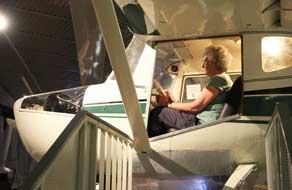 The Norske Luftfarts (Aviation) Museum at Bodø: Bodø was
founded as a small trading settlement in 1816 with a population of just 55 male
inhabitants. The town grew slowly, struggling to survive until the 1860s herring
boom with enormous quantities of herring being landed and processed at Bodø.
With all the associated industries to support the fishing fleet and fish sold at
high prices, the town prospered and new inhabitants flocked here; by 1885 the
population had reached 2,700. During the early 20th century several industrial
plants developed at Bodø which continued to grow as a regional centre. Then on
27 May 1940, the little port of Bodø was razed to the ground by German bombers;
in just 2½ hours most of the town had been reduced to rubble and 2/3s of the
buildings totally destroyed. The city was rebuilt after the war but with none of
the 19th century buildings that once lined the waterfront having survived the
German bombing, the current city's buildings are all modern. The 2014 population
is almost 50,000, and Bodø is the northern terminus of the railway line from
Oslo and Trondheim. The Norske Luftfarts (Aviation) Museum at Bodø: Bodø was
founded as a small trading settlement in 1816 with a population of just 55 male
inhabitants. The town grew slowly, struggling to survive until the 1860s herring
boom with enormous quantities of herring being landed and processed at Bodø.
With all the associated industries to support the fishing fleet and fish sold at
high prices, the town prospered and new inhabitants flocked here; by 1885 the
population had reached 2,700. During the early 20th century several industrial
plants developed at Bodø which continued to grow as a regional centre. Then on
27 May 1940, the little port of Bodø was razed to the ground by German bombers;
in just 2½ hours most of the town had been reduced to rubble and 2/3s of the
buildings totally destroyed. The city was rebuilt after the war but with none of
the 19th century buildings that once lined the waterfront having survived the
German bombing, the current city's buildings are all modern. The 2014 population
is almost 50,000, and Bodø is the northern terminus of the railway line from
Oslo and Trondheim.
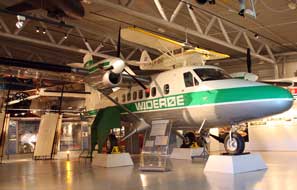 Our first stop the following
morning was at the Norwegian Aviation Museum which we reached after a 15 minute
walk from the campsite. The museum's displays of preserved aircraft document
both Norway's civil and military aviation history, and its building is shaped in
the form of a propeller with one arm housing the civil aircraft and the other
military aircraft of WW2 and the Cold War. The central apex is topped by the
former control tower of Bodø airport. The first displays related the history of
the Norwegian Air Force, founded in 1912 as the Naval and Army air forces which
were only merged into a 3rd military force in 1944 by the government in exile.
Just inside the hall displays describing the principles of flight included a
light aircraft in which visitors could take the pilot's seat and handle the
controls (see above right). The aircraft displays included 2 versions of the de Havilland Twin
Otter which became a mainstay of Norwegian internal civil air transport from the
1960s~90s, an ideal aircraft to open up the country able to land and
take off on just a few 100m of runway or be fitted with skis or floats for
landing on snow or lakes. Another key display was the Junkers JU-52, the only
surviving example of this distinctive aircraft fitted with floats as a seaplane (Photo
34 - Junkers JU-52 seaplane).
Junkers built 4,845 of these aircraft with their distinctive trimotor design and Our first stop the following
morning was at the Norwegian Aviation Museum which we reached after a 15 minute
walk from the campsite. The museum's displays of preserved aircraft document
both Norway's civil and military aviation history, and its building is shaped in
the form of a propeller with one arm housing the civil aircraft and the other
military aircraft of WW2 and the Cold War. The central apex is topped by the
former control tower of Bodø airport. The first displays related the history of
the Norwegian Air Force, founded in 1912 as the Naval and Army air forces which
were only merged into a 3rd military force in 1944 by the government in exile.
Just inside the hall displays describing the principles of flight included a
light aircraft in which visitors could take the pilot's seat and handle the
controls (see above right). The aircraft displays included 2 versions of the de Havilland Twin
Otter which became a mainstay of Norwegian internal civil air transport from the
1960s~90s, an ideal aircraft to open up the country able to land and
take off on just a few 100m of runway or be fitted with skis or floats for
landing on snow or lakes. Another key display was the Junkers JU-52, the only
surviving example of this distinctive aircraft fitted with floats as a seaplane (Photo
34 - Junkers JU-52 seaplane).
Junkers built 4,845 of these aircraft with their distinctive trimotor design and
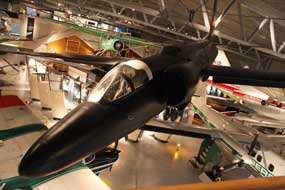 corrugated metal fuselage. It had been the Luftwaffe's main transport aircraft and in 1940 570 Ju-52s
spearheaded the German invasion of Norway dropping parachute troops. In 1936 the
Norwegian Aviation Co had bought 4 Ju-52 seaplanes for use as civilian transport
and after WW2 took over 6 more German Ju-52s to develop air transport in the
north on the Bodø~Harstad~Tromsø route. During the Cold War the USAF used Bodø
as an airbase, and for the CIA high altitude U2 spy-plane flights over USSR, and
one of these black sinister-looking aircraft was displayed in the far corner of
the hall (Photo
35 - U2 high altitude spy-plane). The ill-fated U2 flight in July 1960 in which Gary Powers was shot
down by Soviet missiles over Sverdlovsk was en route from
Peshawar in Pakistan over USSR to the Barents Sea to land at Bodø. In the major
diplomatic incident that followed the U2 shooting down, Khrushchev threatened to bomb Bodø.
From the gallery we were able to examine at close quarters the U2 with its
distinctive small fuselage and lengthy wing surface, designed for cruising
a very high altitude. It was an eerie sensation looking down directly into the
tiny, cramped cockpit in which Powers would have sat on his ill-fated flight
which brought the highly secret U2 to international prominence. corrugated metal fuselage. It had been the Luftwaffe's main transport aircraft and in 1940 570 Ju-52s
spearheaded the German invasion of Norway dropping parachute troops. In 1936 the
Norwegian Aviation Co had bought 4 Ju-52 seaplanes for use as civilian transport
and after WW2 took over 6 more German Ju-52s to develop air transport in the
north on the Bodø~Harstad~Tromsø route. During the Cold War the USAF used Bodø
as an airbase, and for the CIA high altitude U2 spy-plane flights over USSR, and
one of these black sinister-looking aircraft was displayed in the far corner of
the hall (Photo
35 - U2 high altitude spy-plane). The ill-fated U2 flight in July 1960 in which Gary Powers was shot
down by Soviet missiles over Sverdlovsk was en route from
Peshawar in Pakistan over USSR to the Barents Sea to land at Bodø. In the major
diplomatic incident that followed the U2 shooting down, Khrushchev threatened to bomb Bodø.
From the gallery we were able to examine at close quarters the U2 with its
distinctive small fuselage and lengthy wing surface, designed for cruising
a very high altitude. It was an eerie sensation looking down directly into the
tiny, cramped cockpit in which Powers would have sat on his ill-fated flight
which brought the highly secret U2 to international prominence.
The main displays in the second
hall were military aircraft of WW2 and the Cold War flown by the Norwegian Air
Force. A huge diorama recreated the crash scene of a German Ju-88 heavy bomber
in the wilds of Arctic Norway. But the central display was a Mark IX Spitfire
and de Havilland Mosquito both with Norwegian markings; Norwegian Air
 Force
squadrons and Norwegian RAF pilots flew these aircraft in raids on German
shipping along the coast of Norway. Along side the Spitfire was its arch
opponent, the more advanced Focke-Wulf Fw190; this particular model had crashed
near to Berlevåg in December 1943, the remains discovered and salvaged in 1964
and fully restored in 2013 (Photo
36 - Focke-Wulf Fw190 German WW2 fighter). Nearby was a huge Catalina flying boat which
Norwegian pilots flew on anti-U-boat patrols. During the Cold War in the 1950s,
the US under their Military Assistance Programme had armed NATO allies such as
Norway with the latest technological jet aircraft such as the Republic F-84 Thunderjet and North American F-86 Sabre-jet. Later in the 1960s the Norwegian
Air Force purchased 108 Northrop F-5 Freedom Fighters. Examples of all these
formidable-looking aircraft were on display. Force
squadrons and Norwegian RAF pilots flew these aircraft in raids on German
shipping along the coast of Norway. Along side the Spitfire was its arch
opponent, the more advanced Focke-Wulf Fw190; this particular model had crashed
near to Berlevåg in December 1943, the remains discovered and salvaged in 1964
and fully restored in 2013 (Photo
36 - Focke-Wulf Fw190 German WW2 fighter). Nearby was a huge Catalina flying boat which
Norwegian pilots flew on anti-U-boat patrols. During the Cold War in the 1950s,
the US under their Military Assistance Programme had armed NATO allies such as
Norway with the latest technological jet aircraft such as the Republic F-84 Thunderjet and North American F-86 Sabre-jet. Later in the 1960s the Norwegian
Air Force purchased 108 Northrop F-5 Freedom Fighters. Examples of all these
formidable-looking aircraft were on display.
We concluded our visit in the
central control tower, very hot in today's sunshine but with impressive views
across Bodø airport runway and radar dome to the distant snowy peaks. Bodø's
Norske Luftfarts Museum had an admirable and unique collection of both civil and
military aircraft, but despite the building's design, the displays were far more
crammed in with much dimmer lighting than the equivalent Swedish Aircraft Museum
at Linköping which we visited last year; its far more spacious and well-lit
halls made photographing the aircraft far easier, which is after all what
most visitors want.
 Our visit to Bodø: from outside the museum we caught the #3 bus
into the centre of Bodø with the intention of waving off the south-bound
Hurtigrute which we believed was due to depart at 4-15pm. We got off the bus at Bodø
Stasjon and set off at a brisk pace along towards the ferry terminals. Cars,
lorries and passengers were queuing for the Lofoten Islands ferry to Moskenes,
but in puzzlement we could see no sign of the Hurtigrute at the quay. At the
freight-yard, fork-lift trucks now stood idle and the gates were firmly locked;
the express-liner had already sailed, and reading the timetable more closely, we
had mis-read 4-00am for 4-00 pm and were 12 hours too late! Back along the main
road, and impressed by Nordic civility with cars and even lorries stopping
voluntarily to allow pedestrian to cross, we returned to the railway station
where the 16-05 train for Rognan was waiting by the buffers (see right), literally the end of
the line at the railway's unassuming northern terminus here in Bodø (Photo
37 - End of the line at Bodø railway station). Our visit to Bodø: from outside the museum we caught the #3 bus
into the centre of Bodø with the intention of waving off the south-bound
Hurtigrute which we believed was due to depart at 4-15pm. We got off the bus at Bodø
Stasjon and set off at a brisk pace along towards the ferry terminals. Cars,
lorries and passengers were queuing for the Lofoten Islands ferry to Moskenes,
but in puzzlement we could see no sign of the Hurtigrute at the quay. At the
freight-yard, fork-lift trucks now stood idle and the gates were firmly locked;
the express-liner had already sailed, and reading the timetable more closely, we
had mis-read 4-00am for 4-00 pm and were 12 hours too late! Back along the main
road, and impressed by Nordic civility with cars and even lorries stopping
voluntarily to allow pedestrian to cross, we returned to the railway station
where the 16-05 train for Rognan was waiting by the buffers (see right), literally the end of
the line at the railway's unassuming northern terminus here in Bodø (Photo
37 - End of the line at Bodø railway station).
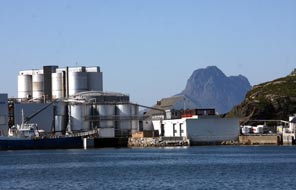 We walked along the waterfront,
photographing the fishing boats against a backdrop of oil storage tanks across
the harbour and distant jagged mountain peaks (see left). Up the steep hill to the main
square of Torget, a statue of a gaunt-looking King Håkon VII gazed wistfully out
to sea, recalling his fleeing from Oslo and the German invaders in May 1940 and
his escape into 5 years exile in Exile (Photo
38 - Statue of King Håkon VII at Bodø). Just around the corner we found the Domkirke, a huge formless concrete barn of a building with its skeletal concrete
bell tower and lacking any charm or grace. Bodø's original church was destroyed
by German bombing in 1940, and its replacement had been completed in 1956
following an architectural competition; if We walked along the waterfront,
photographing the fishing boats against a backdrop of oil storage tanks across
the harbour and distant jagged mountain peaks (see left). Up the steep hill to the main
square of Torget, a statue of a gaunt-looking King Håkon VII gazed wistfully out
to sea, recalling his fleeing from Oslo and the German invaders in May 1940 and
his escape into 5 years exile in Exile (Photo
38 - Statue of King Håkon VII at Bodø). Just around the corner we found the Domkirke, a huge formless concrete barn of a building with its skeletal concrete
bell tower and lacking any charm or grace. Bodø's original church was destroyed
by German bombing in 1940, and its replacement had been completed in 1956
following an architectural competition; if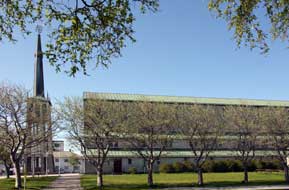 this was the winning design, whatever
must the unsuccessful offering have looked like! From whichever angle you tried
to photograph it, even with its starkness relieved by trees, it still resembled
a huge and formless concrete barn. The bronze doors were firmly locked, and as
we sat considering what delights we might be missing inside, we got into
conversation with a charming French couple from Avignon who were about to set
off on a walking tour in the Lofotens. We had never believed that in Northern
Norway we should be using our long-forgotten French, and it was not to be the
last time we should meet this couple. this was the winning design, whatever
must the unsuccessful offering have looked like! From whichever angle you tried
to photograph it, even with its starkness relieved by trees, it still resembled
a huge and formless concrete barn. The bronze doors were firmly locked, and as
we sat considering what delights we might be missing inside, we got into
conversation with a charming French couple from Avignon who were about to set
off on a walking tour in the Lofotens. We had never believed that in Northern
Norway we should be using our long-forgotten French, and it was not to be the
last time we should meet this couple.
Understandably modern thanks to
German wartime aggression, Bodø as a city could certainly not be described as an
elegant place, and we wandered back down to the centre to shop for provisions at
an even more expensive than usual supermarket and to catch our bus back out to
the campsite.
E6 north over the mountains: leaving Bodø, we headed back along
Route 80 to Fauske, planning to camp overnight at 1 of the 2 campsites there;
both had pretentious names involving variants of Fauske camping-motel or hotel
with silly prices to match, certainly enough to deter. We therefore moved on over
a gloomily dismal valley hemmed in by high fells, and some 12kms north found the
welcoming Strømhaug Camping in the village of Straumen just off E6 at the head
of Sørfolda Fjord.
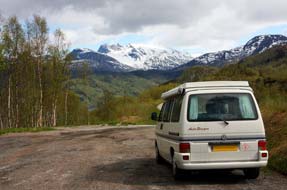 The small
campsite, with flat, grassy camping area alongside a fast-flowing river,
site-wide wi-fi internet, and recently upgraded facilities, was
surrounded by high mountains, and we settled in with the heater on against the
bitterly chill wind driving down from the north; the weather forecast promised a
return to milder sunnier weather in the coming days. The small
campsite, with flat, grassy camping area alongside a fast-flowing river,
site-wide wi-fi internet, and recently upgraded facilities, was
surrounded by high mountains, and we settled in with the heater on against the
bitterly chill wind driving down from the north; the weather forecast promised a
return to milder sunnier weather in the coming days.
The E6 north from Straumen passed
through a series of poorly lit tunnels through the craggy mountain side and
alongside Leirfjord, turning inland to gain height steeply through another
tunnel. From the watershed with spectacular views ahead of snow-covered Sildhopfjellet, the road began a long descent through the 4.7km long Kobbskar
tunnel, an unnerving sensation descending so rapidly in darkness, and emerged
again at fjord level at the small settlement of Mørsvikbotn. E6 now began a long
and serious ascent into high mountainous terrain with distant snow-covered
shapely peaks in all directions. Higher and higher we climbed above the level of
pines, then higher through the here leafless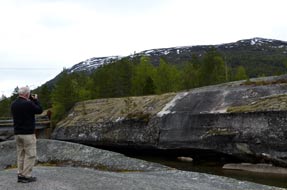 birches to reach a desolate
plateau, looking out across frozen lakes and snow-covered wilderness of peaks.
The road beyond continued to gain height into even more spectacular snowy
mountainous surroundings, a bleak black and white monochrome environment on the
dull overcast day (Photo
39 - E6 north over snowy mountains), finally beginning a long and winding descent past a further
impressive range of peaks, and dropping down past Rotvatnet to the broad Sagelva
valley. birches to reach a desolate
plateau, looking out across frozen lakes and snow-covered wilderness of peaks.
The road beyond continued to gain height into even more spectacular snowy
mountainous surroundings, a bleak black and white monochrome environment on the
dull overcast day (Photo
39 - E6 north over snowy mountains), finally beginning a long and winding descent past a further
impressive range of peaks, and dropping down past Rotvatnet to the broad Sagelva
valley.
At a road junction where a minor
road branched off to the coast, a brown sign pointed to Helleristningsfelt
(Rock engravings). We turned into the car park where an information panel
detailed the stone age art work, created some 8,000 years ago not by
chip-engraving but by polishing the outlines of reindeer onto the panels of
glacially smoothed rock. A pathway led to where, on the almost vertical rock
panels above the water-course, we could see the life-sized outlines of 2
reindeer (see right); the better preserved engraving showed clearly the antlered head bent
as if to drink, gracefully portrayed with naturalistic style (Photo
40 - Sagelva reindeer rock engravings).
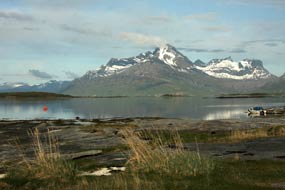 A memorable campsite at Skutvik
ready for the Lofoten ferry: beyond the large village of Innhavet, the
now more narrow E6 gained height up through delightful wooded hill-country to
reach a viewpoint with an unbelievably spectacular skyline of jagged snowy
peaks; here was our first distant view of Lofoten's renowned mountainous
profile, and the nearer peaks of the Finnøya and Hamarøya peninsulas (Photo
41 - First view of distant Lofoten peaks). Dropping
steeply down to fjord level through a bleak monochrome wilderness of lakes and
fell, we reached the road junction at Ulsvåg where E6 continued northwards to
Narvik; we should return this way in 2 months time on our way south from Finmark.
Today we turned off onto the more narrow Route 81 for the final 30kms drive out
to the tiny port of Skutvik. The lane twisted and turned through wooded
fell-land with views between the pines of shapely peaks, crossing a
flimsy-looking suspension bridge into the village of Oppeid. Beyond A memorable campsite at Skutvik
ready for the Lofoten ferry: beyond the large village of Innhavet, the
now more narrow E6 gained height up through delightful wooded hill-country to
reach a viewpoint with an unbelievably spectacular skyline of jagged snowy
peaks; here was our first distant view of Lofoten's renowned mountainous
profile, and the nearer peaks of the Finnøya and Hamarøya peninsulas (Photo
41 - First view of distant Lofoten peaks). Dropping
steeply down to fjord level through a bleak monochrome wilderness of lakes and
fell, we reached the road junction at Ulsvåg where E6 continued northwards to
Narvik; we should return this way in 2 months time on our way south from Finmark.
Today we turned off onto the more narrow Route 81 for the final 30kms drive out
to the tiny port of Skutvik. The lane twisted and turned through wooded
fell-land with views between the pines of shapely peaks, crossing a
flimsy-looking suspension bridge into the village of Oppeid. Beyond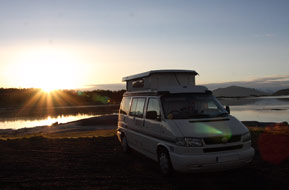 here, the
terrain opened up with farms dominated by prominent peaks, the lane finally
ending at Skutvik where a few vehicles were waiting for the evening ferry to
Svalvær. Before driving out to Ness Camping, we checked tomorrow morning ferry
timetable, and it was a good thing we did: a new summer season timetable had
just started with times different from our expectations. Just outside the port,
we turned off on a single-track lane leading out to Ness and its little campsite.
Immediate impressions were good: a wide shore-side gravelled camping area
looking out across the bay towards the serried ranks of Finnøya snow-covered
peaks (see above left). It was another of those unforgettably spectacular settings which will
doubtless grow in the recalling (Photo
42 - Ness Camping at Skutvik). here, the
terrain opened up with farms dominated by prominent peaks, the lane finally
ending at Skutvik where a few vehicles were waiting for the evening ferry to
Svalvær. Before driving out to Ness Camping, we checked tomorrow morning ferry
timetable, and it was a good thing we did: a new summer season timetable had
just started with times different from our expectations. Just outside the port,
we turned off on a single-track lane leading out to Ness and its little campsite.
Immediate impressions were good: a wide shore-side gravelled camping area
looking out across the bay towards the serried ranks of Finnøya snow-covered
peaks (see above left). It was another of those unforgettably spectacular settings which will
doubtless grow in the recalling (Photo
42 - Ness Camping at Skutvik).
The lady-owner arrived and
welcomed us with a reduced price as one of the season's earliest guests and gave
us the wi-fi pass-word; such a lovely welcome to complement a magnificent
setting just had to merit our +5 highest rating. We had both the campsite and
entire bay to ourselves with the heavenly peace broken only by the sound of
birds. We quickly settled in and binoculars were soon out: oyster-catchers
'peeping' loudly, ringed
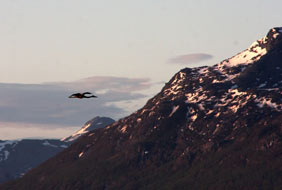 plovers pecking in the shoreline mud, and most
spectacularly common terns soaring above the bay and hovering with rapidly
flapping wings to dive for fish. At 3-00am the following morning, with the new
light of the rising sun catching the surrounding mountains with its pinkish
glow (see above right) (Photo
43 - Dawn over Skutvik), a heron soared across the bay (see left) cawing after an aerial tussle with a gull,
and later as we sat out for breakfast a curlew announced his arrival with his
'kettle's boiling' crescendo as he paraded along the shoreline rocks. It was a
wonderfully peaceful morning (Photo
44 - Early morning at Skutvik). plovers pecking in the shoreline mud, and most
spectacularly common terns soaring above the bay and hovering with rapidly
flapping wings to dive for fish. At 3-00am the following morning, with the new
light of the rising sun catching the surrounding mountains with its pinkish
glow (see above right) (Photo
43 - Dawn over Skutvik), a heron soared across the bay (see left) cawing after an aerial tussle with a gull,
and later as we sat out for breakfast a curlew announced his arrival with his
'kettle's boiling' crescendo as he paraded along the shoreline rocks. It was a
wonderfully peaceful morning (Photo
44 - Early morning at Skutvik).
After our long but spectacular drive over the mountains to reach Skutvik, here
at Ness Camping we had a wonderfully peaceful setting with memorable mountain
views and bonus of birdlife. At what was surely one of the finest campsites we
had ever stayed at in almost 50 years of camping, we could revel in the
astounding views with warm sunshine and clear light for photography, perfect
weather and perfect mountain setting for a productively relaxing day in camp. We
sat up late into the evening with the sun declining behind a hill, before
tomorrow's ferry crossing to begin the next phase of the trip on the Lofoten and
Vesterålen Islands.
Next edition
to be published quite soon
|
Sheila and Paul |
Published: 31 August 2014 at
Undredal, Aurlandsfjord |
|

 CAMPING
IN NORWAY 2014 - Trondheim, E6 north to Mo-i-Rana and Bodø, crossing the Arctic Circle
on Saltjell, and Skutvik for ferry to Lofoten
Islands:
CAMPING
IN NORWAY 2014 - Trondheim, E6 north to Mo-i-Rana and Bodø, crossing the Arctic Circle
on Saltjell, and Skutvik for ferry to Lofoten
Islands: precipitous-sided defile of Drivdalen, with the railway line running along a
shelf in the narrow confines of the gorge on the far side of the river
torrent (see left). At the northern end of the pass, the valley sides opened up into
broader farming country leading to the small town of Oppdal whose residents we
had joined last week for their National Day celebratory procession up at
Hjerkinn on Dovrefjell. How warm the Spring air in the valley felt as we
descended from the still wintry high mountainous terrain. The Trondheim railway
continued to parallel the E6, following the line of valleys through
pine-forested rolling hill-country, and gradually the terrain broadened into
lowland farming country and small outlying towns as we approached the outskirts
of Trondheim. Traffic inevitably increased as we turned NE around the ring-road
through the city's conurbation, clocking up more tolls passing through more Autopass 'bomstasjons'.
precipitous-sided defile of Drivdalen, with the railway line running along a
shelf in the narrow confines of the gorge on the far side of the river
torrent (see left). At the northern end of the pass, the valley sides opened up into
broader farming country leading to the small town of Oppdal whose residents we
had joined last week for their National Day celebratory procession up at
Hjerkinn on Dovrefjell. How warm the Spring air in the valley felt as we
descended from the still wintry high mountainous terrain. The Trondheim railway
continued to parallel the E6, following the line of valleys through
pine-forested rolling hill-country, and gradually the terrain broadened into
lowland farming country and small outlying towns as we approached the outskirts
of Trondheim. Traffic inevitably increased as we turned NE around the ring-road
through the city's conurbation, clocking up more tolls passing through more Autopass 'bomstasjons'. From the E6, we turned down to Vikhammer
Camping on the Trondheim fjord shore-line, our base for visiting the city. The
campsite reception was welcoming and had responded to our earlier email enquiry
about buses, but the camping area was sordidly unkempt, seemingly full of
semi-derelict static caravans with little space for visitors, and the air filled
with the noise of passing trains, aircraft, revving cars and rowdiness of
resident migrant workers. But it was a convenient base for visiting Trondheim
with ready bus access into the city, and we found a corner space to settle in
overlooking the fjord. The air temperature down at the coast was a balmy 25°,
and our first priority was to change out of our arctic gear! But the noise
levels made us long to be back in the peace and chill of the mountains. The
evening's highlight was a superb sunset across the fjord (see left) (
From the E6, we turned down to Vikhammer
Camping on the Trondheim fjord shore-line, our base for visiting the city. The
campsite reception was welcoming and had responded to our earlier email enquiry
about buses, but the camping area was sordidly unkempt, seemingly full of
semi-derelict static caravans with little space for visitors, and the air filled
with the noise of passing trains, aircraft, revving cars and rowdiness of
resident migrant workers. But it was a convenient base for visiting Trondheim
with ready bus access into the city, and we found a corner space to settle in
overlooking the fjord. The air temperature down at the coast was a balmy 25°,
and our first priority was to change out of our arctic gear! But the noise
levels made us long to be back in the peace and chill of the mountains. The
evening's highlight was a superb sunset across the fjord (see left) ( Trondheim's history: the #38 bus runs regularly from Hommelvik along
the coast past Vikhammer into Trondheim, and although even seniors' ticket (honnør)
prices are expensive at 25 NOK per journey, the bus dropped us at Dronnings gata in the city centre. With just 160,000 residents, Trondheim is
Norway's 3rd largest city after Oslo and Bergen. Originally called Nidaros
(meaning mouth of the Nid River), the city gained the name Trondhjem (pronounced Trond-yem) since late medieval times. But in the early 20th century in a
fit of Norwegian nationalistic pride, the newly independent government tried to
revert to the name Nidaros, provoking outraged protests from Trondhjemers. A
compromise was duly reached with the name Trondheim. The city's origins go back
to 997 AD when the Viking King Olav Tryggvason moored his longship alongside a
sandbank at the mouth of the Nid River and established a farming settlement on
the triangular peninsula of land formed by the river's meander. In 1030,
Trondheim's history: the #38 bus runs regularly from Hommelvik along
the coast past Vikhammer into Trondheim, and although even seniors' ticket (honnør)
prices are expensive at 25 NOK per journey, the bus dropped us at Dronnings gata in the city centre. With just 160,000 residents, Trondheim is
Norway's 3rd largest city after Oslo and Bergen. Originally called Nidaros
(meaning mouth of the Nid River), the city gained the name Trondhjem (pronounced Trond-yem) since late medieval times. But in the early 20th century in a
fit of Norwegian nationalistic pride, the newly independent government tried to
revert to the name Nidaros, provoking outraged protests from Trondhjemers. A
compromise was duly reached with the name Trondheim. The city's origins go back
to 997 AD when the Viking King Olav Tryggvason moored his longship alongside a
sandbank at the mouth of the Nid River and established a farming settlement on
the triangular peninsula of land formed by the river's meander. In 1030,
 Olav Haraldsson founded the cathedral at Nidaros, having with ruthless zeal imposed
Christianity on the country and incurred the opposition of pagan
landowners. They aligned themselves with Olav's rival, Knut king of Denmark and
England, and killed Olav at the Battle of Stiklestad. Desperately needing a
local hero to bolster its failing credibility, the early Norse church canonised
Olav, martyred it was claimed for his Christian beliefs; his remains were interred in Nidaros Cathedral which soon became a centre
of pilgrimage. The cult of St Olav lasted until Norway's subjugation by the
Danish kingdom and imposition of Lutheranism with the 1537 Reformation.
Trondheim had been Norway's royal and religious capital until 1217 with the
archbishops becoming rich and powerful. The city had developed and prospered as
a trading centre on the wedge of land in the Nidaros estuary, but the medieval wooden
city was destroyed by fire in 1681. The Danish governor commissioned a
Luxembourg military engineer Caspar de Cicignon to rebuild the city on a grid
plan with broad avenues as fire-breaks, and this design survives to give the
city centre the open feel seen today. Colourful wooden warehouses along the
banks of the Nid bear witness to Trondheim's mercantile wealth. In WW2 the
German invaders made Trondheim their main northern naval base, and the
battleship Tirpitz was anchored at Fættenfjord just to the north.
Trondheim managed to survive without major war damage, and today is a lively
university city.
Olav Haraldsson founded the cathedral at Nidaros, having with ruthless zeal imposed
Christianity on the country and incurred the opposition of pagan
landowners. They aligned themselves with Olav's rival, Knut king of Denmark and
England, and killed Olav at the Battle of Stiklestad. Desperately needing a
local hero to bolster its failing credibility, the early Norse church canonised
Olav, martyred it was claimed for his Christian beliefs; his remains were interred in Nidaros Cathedral which soon became a centre
of pilgrimage. The cult of St Olav lasted until Norway's subjugation by the
Danish kingdom and imposition of Lutheranism with the 1537 Reformation.
Trondheim had been Norway's royal and religious capital until 1217 with the
archbishops becoming rich and powerful. The city had developed and prospered as
a trading centre on the wedge of land in the Nidaros estuary, but the medieval wooden
city was destroyed by fire in 1681. The Danish governor commissioned a
Luxembourg military engineer Caspar de Cicignon to rebuild the city on a grid
plan with broad avenues as fire-breaks, and this design survives to give the
city centre the open feel seen today. Colourful wooden warehouses along the
banks of the Nid bear witness to Trondheim's mercantile wealth. In WW2 the
German invaders made Trondheim their main northern naval base, and the
battleship Tirpitz was anchored at Fættenfjord just to the north.
Trondheim managed to survive without major war damage, and today is a lively
university city. a pleasant air along with its shoppers and buskers
(
a pleasant air along with its shoppers and buskers
( Trondheim's Hjemmefront Museet (Resistance
Museum): with the Cathedral closed this afternoon for a ceremonial
service attended by King Harold and Queen Sonja to commemorate the completion of
the organ restoration, we walked along to the free-entry Hjemmefront Museet
(Resistance Museum) whose main displays describe the carefully planned German
invasion of Norway in April 1940 with concerted sea-borne and aerial attacks on
Oslo, Kristiansand, Trondheim and Narvik, and subsequent Norwegian opposition to
the occupation. An outpost of the equivalent Oslo Museum which we had visited
earlier, the Trondheim museum was organised around a number of themes:
Quisling's radio broadcast announcing his take-over of government, life under
the 5 year occupation, and the development of organised resistance. One display
was devoted to the resistance hero Leif Larsen's abortive attempt to tow the
Royal Navy 2-man human torpedoes up Trondheim Fjord behind his fishing boat Arthur
to attack the Tirpitz at her Fættenfjord anchorage. Another display included an
enigma encoding machine (see right). What
particularly commended the Trondheim museum was its more frank treatment of the
issue of Norwegian collaboration and the number of Norwegians who volunteered both to
work for the Germans and be recruited into the SS to fight Bolshevism on
the Eastern Front as the propaganda posters urged. Another display was
Trondheim's Hjemmefront Museet (Resistance
Museum): with the Cathedral closed this afternoon for a ceremonial
service attended by King Harold and Queen Sonja to commemorate the completion of
the organ restoration, we walked along to the free-entry Hjemmefront Museet
(Resistance Museum) whose main displays describe the carefully planned German
invasion of Norway in April 1940 with concerted sea-borne and aerial attacks on
Oslo, Kristiansand, Trondheim and Narvik, and subsequent Norwegian opposition to
the occupation. An outpost of the equivalent Oslo Museum which we had visited
earlier, the Trondheim museum was organised around a number of themes:
Quisling's radio broadcast announcing his take-over of government, life under
the 5 year occupation, and the development of organised resistance. One display
was devoted to the resistance hero Leif Larsen's abortive attempt to tow the
Royal Navy 2-man human torpedoes up Trondheim Fjord behind his fishing boat Arthur
to attack the Tirpitz at her Fættenfjord anchorage. Another display included an
enigma encoding machine (see right). What
particularly commended the Trondheim museum was its more frank treatment of the
issue of Norwegian collaboration and the number of Norwegians who volunteered both to
work for the Germans and be recruited into the SS to fight Bolshevism on
the Eastern Front as the propaganda posters urged. Another display was
 devoted
to Henry Rinnan, the infamous and sadistic Trondheim collaborator whose gang
cooperated with the Gestapo to betray, imprison, torture and murder several 100s
of Resistance members; he was executed for treason in 1947. A memorial hall
commemorated the 1,300 men and women of Central Norway killed during WW2.
devoted
to Henry Rinnan, the infamous and sadistic Trondheim collaborator whose gang
cooperated with the Gestapo to betray, imprison, torture and murder several 100s
of Resistance members; he was executed for treason in 1947. A memorial hall
commemorated the 1,300 men and women of Central Norway killed during WW2. Icelandic chronicler in his Olav the Holy Saga reports that the church was built on the spit where Olav's
body was hidden on the night of his death at Stiklestad before being buried
further along the river where the Nidaros Cathedral now stands. Excavations
under the library revealed
Icelandic chronicler in his Olav the Holy Saga reports that the church was built on the spit where Olav's
body was hidden on the night of his death at Stiklestad before being buried
further along the river where the Nidaros Cathedral now stands. Excavations
under the library revealed parts of the church and graveyard with the skeletal
remains of 3 adults and an infant now displayed in the ruins under the library's
forecourt.
parts of the church and graveyard with the skeletal
remains of 3 adults and an infant now displayed in the ruins under the library's
forecourt. A charmingly gentle lad, he spoke of missing his family and
hoped to bring his mother for a holiday in Norway since she could not
believe that people could walk on snow and ice! We got off the bus at the Bakke
Bru and set off in bright morning sunshine towards the harbour to wave off the
north-bound Hurtigrute coastal express. During previous visits to Northern
Norway, we had regularly made a point of seeing the ships which for over 100
years have sailed daily between Bergen and Kirkenes, calling at isolated coastal
communities and providing not only a unique tourist service but an essential
year-round delivery lifeline of both freight, supplies, mail and passengers; see
A charmingly gentle lad, he spoke of missing his family and
hoped to bring his mother for a holiday in Norway since she could not
believe that people could walk on snow and ice! We got off the bus at the Bakke
Bru and set off in bright morning sunshine towards the harbour to wave off the
north-bound Hurtigrute coastal express. During previous visits to Northern
Norway, we had regularly made a point of seeing the ships which for over 100
years have sailed daily between Bergen and Kirkenes, calling at isolated coastal
communities and providing not only a unique tourist service but an essential
year-round delivery lifeline of both freight, supplies, mail and passengers; see  Hurtigruten schedule, and the daily
north-bound ship departs at noon. Following passengers returning to the
Hurtigruten quay,
we walked around to the dockside where M/S Midnatsol (Midnight Sun) stood waiting to depart
(see left) (
Hurtigruten schedule, and the daily
north-bound ship departs at noon. Following passengers returning to the
Hurtigruten quay,
we walked around to the dockside where M/S Midnatsol (Midnight Sun) stood waiting to depart
(see left) ( A walk through Nedre Elvehavn and
Baklandet:
crossing the Verftsbru footbridge (see left), decorated in tastefully Scandinavian style
with planters of scented pansies, we reached the former shipyard and industrial
workshop area of Nedre Elvehavn which closed in the 1990s and is now filled with
A walk through Nedre Elvehavn and
Baklandet:
crossing the Verftsbru footbridge (see left), decorated in tastefully Scandinavian style
with planters of scented pansies, we reached the former shipyard and industrial
workshop area of Nedre Elvehavn which closed in the 1990s and is now filled with popular waterside bars and restaurants busy in the bright lunchtime sunshine (
popular waterside bars and restaurants busy in the bright lunchtime sunshine ( Trondheim's Nidaros Cathedral:
back across the footbridge, we walked up to Nidaros Cathedral whose
apparently small size and grey stonework belie its reputation as Northern
Europe's masterpiece of Medieval Gothic architecture (see left). Dedicated to St Olaf with
its altar set over the saint's grave, the original
Trondheim's Nidaros Cathedral:
back across the footbridge, we walked up to Nidaros Cathedral whose
apparently small size and grey stonework belie its reputation as Northern
Europe's masterpiece of Medieval Gothic architecture (see left). Dedicated to St Olaf with
its altar set over the saint's grave, the original  stone Cathedral of Nidaros,
the earliest parts dating from 1153 when Norway became a separate bishopric, has
suffered several fires over the centuries along with the upheavals of the
Reformation which robbed the Church of its riches. The original Gothic transept
built around 1180 shows Anglo-Norman influences with many of the craftsmen and
stonemasons brought over from England. The Cathedral's crowning glory is the
magnificent west end façade and rose window (
stone Cathedral of Nidaros,
the earliest parts dating from 1153 when Norway became a separate bishopric, has
suffered several fires over the centuries along with the upheavals of the
Reformation which robbed the Church of its riches. The original Gothic transept
built around 1180 shows Anglo-Norman influences with many of the craftsmen and
stonemasons brought over from England. The Cathedral's crowning glory is the
magnificent west end façade and rose window ( and justification for canonisation. The 4th panel portrays church
officials exhuming Olaf's uncorrupted body and declaring his sainthood (see
right). What is
not to be seen now is the object of medieval pilgrims' veneration, St Olaf's
silver reliquary casket which originally
rested under the Cathedral's altar; it was removed to Copenhagen after the 1537
Reformation and unceremoniously melted down for coinage.
and justification for canonisation. The 4th panel portrays church
officials exhuming Olaf's uncorrupted body and declaring his sainthood (see
right). What is
not to be seen now is the object of medieval pilgrims' veneration, St Olaf's
silver reliquary casket which originally
rested under the Cathedral's altar; it was removed to Copenhagen after the 1537
Reformation and unceremoniously melted down for coinage. Trondheim's Trampe-Sykkelheis cycle-lift and
the Kristiansten Fortress:
crossing the bridge once more, we faced the ultra-steep climb up the Brubakken
hill to reach the Kristiansten Fortress. Cyclists tackling the hill have no such
problems since the Trondheim authorities have provided the world's only
cycle-lift, the Trampe-Sykkelheis, another of the cycle-friendly city's curiosities (
Trondheim's Trampe-Sykkelheis cycle-lift and
the Kristiansten Fortress:
crossing the bridge once more, we faced the ultra-steep climb up the Brubakken
hill to reach the Kristiansten Fortress. Cyclists tackling the hill have no such
problems since the Trondheim authorities have provided the world's only
cycle-lift, the Trampe-Sykkelheis, another of the cycle-friendly city's curiosities ( great fire as defence for the
re-built city. The surviving earth fortifications and stone redoubts give
panoramic views over the city centre within the triangular peninsula enclosed by
the Nidelv's meander, and the modern suburban conurbation spreading beyond. Up
through the gate-house, we clambered onto the ramparts to photograph the views
in the now hazy conditions (see right).
great fire as defence for the
re-built city. The surviving earth fortifications and stone redoubts give
panoramic views over the city centre within the triangular peninsula enclosed by
the Nidelv's meander, and the modern suburban conurbation spreading beyond. Up
through the gate-house, we clambered onto the ramparts to photograph the views
in the now hazy conditions (see right).  Photographic
disaster at Hell: in pouring rain the following morning, we re-joined
the E6 motorway heading north through the 4km long Hell Tunnel which emerges
close to Trondheim airport and a turning to the quaintly named rail junction and
village of Hell (meaning 'well-being' in Norwegian!). Unable to
Photographic
disaster at Hell: in pouring rain the following morning, we re-joined
the E6 motorway heading north through the 4km long Hell Tunnel which emerges
close to Trondheim airport and a turning to the quaintly named rail junction and
village of Hell (meaning 'well-being' in Norwegian!). Unable to
 resist
the temptation to take a brief look at Hell, with the rain still pouring
we turned off and parked at the little station, with endless puns about the name
and Hellish weather. Just managing to get one photograph of the station sign
'Hell - gods expedition' (Hell - have a good journey), disaster
struck: Paul's camera lens jammed and no amount of turning or pushing would
shift it. That's what happens when you go to Hell and try to take photographs,
but wise cracks failed to fix the offending lens. The thought of facing the rest
of the trip sans camera was unthinkable, and it was fortunate we were still
within range of the city; there was nothing for it but to return to Vikhammer
Camping and ask advice from the professional photographer who shared the
premises about photographic shops in Trondheim. By 4-00pm we were back by bus
into Trondheim city centre at Japan Foto in Munke gata; the lens was beyond
repair and had to be replaced. We were back in business but the cost in
Norwegian kroner did not bear thinking about! After an unexpected extra night at
Vikhammer Camping, we returned to Hell in better weather the following morning
to re-photograph in better light the station with its punning sign-board, even recording the
times of trains to and from Hell. We could now say that we had been to Hell and
that it did not always rain there (see right).
resist
the temptation to take a brief look at Hell, with the rain still pouring
we turned off and parked at the little station, with endless puns about the name
and Hellish weather. Just managing to get one photograph of the station sign
'Hell - gods expedition' (Hell - have a good journey), disaster
struck: Paul's camera lens jammed and no amount of turning or pushing would
shift it. That's what happens when you go to Hell and try to take photographs,
but wise cracks failed to fix the offending lens. The thought of facing the rest
of the trip sans camera was unthinkable, and it was fortunate we were still
within range of the city; there was nothing for it but to return to Vikhammer
Camping and ask advice from the professional photographer who shared the
premises about photographic shops in Trondheim. By 4-00pm we were back by bus
into Trondheim city centre at Japan Foto in Munke gata; the lens was beyond
repair and had to be replaced. We were back in business but the cost in
Norwegian kroner did not bear thinking about! After an unexpected extra night at
Vikhammer Camping, we returned to Hell in better weather the following morning
to re-photograph in better light the station with its punning sign-board, even recording the
times of trains to and from Hell. We could now say that we had been to Hell and
that it did not always rain there (see right). The
safe anchorage at Fættenfjord was protected from aerial attack by the
surrounding hills and from naval attacks by coastal gun emplacements. A constant
threat to Allied shipping, Tirpitz was continually observed by RAF photo
reconnaissance Spitfires. Bombing missions failed to make any impact since at
that time the RAF had no bombs big enough to pierce the battleship's armour
plating, and bomb-aiming techniques were insufficiently accurate, resulting in
major losses of aircraft and crews who were buried and commemorated at the CWGC
cemetery in Trondheim.
The
safe anchorage at Fættenfjord was protected from aerial attack by the
surrounding hills and from naval attacks by coastal gun emplacements. A constant
threat to Allied shipping, Tirpitz was continually observed by RAF photo
reconnaissance Spitfires. Bombing missions failed to make any impact since at
that time the RAF had no bombs big enough to pierce the battleship's armour
plating, and bomb-aiming techniques were insufficiently accurate, resulting in
major losses of aircraft and crews who were buried and commemorated at the CWGC
cemetery in Trondheim. mission was dogged by misfortune: Arthur suffered several engine
failures, then when a storm brewed up both Chariots broke adrift from her
mountings under the Arthur's keel and sank in the fjord's deep waters.
The mission had to be aborted:
Arthur was scuttled and
Larsen, his 3 Norwegian crew and 6 Royal Navy divers and crew set off on foot
over the mountains. All managed to escape across the border into neutral Sweden,
except one British sailor, AB Evans who was wounded in a skirmish with a German
patrol and left to be taken POW. He was later executed by the Germans, one of
the war crimes cited against Dönitz at the 1945 Nuremberg Trials.
mission was dogged by misfortune: Arthur suffered several engine
failures, then when a storm brewed up both Chariots broke adrift from her
mountings under the Arthur's keel and sank in the fjord's deep waters.
The mission had to be aborted:
Arthur was scuttled and
Larsen, his 3 Norwegian crew and 6 Royal Navy divers and crew set off on foot
over the mountains. All managed to escape across the border into neutral Sweden,
except one British sailor, AB Evans who was wounded in a skirmish with a German
patrol and left to be taken POW. He was later executed by the Germans, one of
the war crimes cited against Dönitz at the 1945 Nuremberg Trials. this was a hospitably welcoming campsite in such
wretched weather (see left); and the forecast was not much better for our onward northern
journey.
this was a hospitably welcoming campsite in such
wretched weather (see left); and the forecast was not much better for our onward northern
journey.  During the 9th century AD, Norway had been divided between several local Viking
chieftain-kings, each controlling their own petty fiefdom. Harald Fairhair (Hårfagri)
in military alliance with the Jarls of Lade in Trøndelag had managed to unify
the kingdom briefly, but after his death his descendents spent the 10th century
in warring power feuds. Religion also played a part in these power struggles as
Håkon the Good and Olaf Tryggvason attempted by bloody force to convert the
pagan Norwegians to Christianity. In 1015, Olaf Haraldsson, another of Harald
Fairhair's descendents who had converted to Christianity during his childhood
upbringing in England, returned to Norway to gain the kingdom. While his rival,
Knut the Great of Denmark, was preoccupied with wars in England, Olaf with a
peasant army secured the Norwegian throne. During his brief reign, Olaf with
Christianising zeal forced the new religion on his subjects with a regime of
brutal executions and torture, so alienating the major land-owning
classes such as Dale Gudbrand whom we had met at Hunsdorp in the valley of Gudbrandsdalen
that still bears his name. Olaf's hold on power lasted only until 1028: Knut in
alliance with the Jarls of Lade
During the 9th century AD, Norway had been divided between several local Viking
chieftain-kings, each controlling their own petty fiefdom. Harald Fairhair (Hårfagri)
in military alliance with the Jarls of Lade in Trøndelag had managed to unify
the kingdom briefly, but after his death his descendents spent the 10th century
in warring power feuds. Religion also played a part in these power struggles as
Håkon the Good and Olaf Tryggvason attempted by bloody force to convert the
pagan Norwegians to Christianity. In 1015, Olaf Haraldsson, another of Harald
Fairhair's descendents who had converted to Christianity during his childhood
upbringing in England, returned to Norway to gain the kingdom. While his rival,
Knut the Great of Denmark, was preoccupied with wars in England, Olaf with a
peasant army secured the Norwegian throne. During his brief reign, Olaf with
Christianising zeal forced the new religion on his subjects with a regime of
brutal executions and torture, so alienating the major land-owning
classes such as Dale Gudbrand whom we had met at Hunsdorp in the valley of Gudbrandsdalen
that still bears his name. Olaf's hold on power lasted only until 1028: Knut in
alliance with the Jarls of Lade
 expelled him and Olaf fled to Sweden. He managed
to raise a small rag-tag army and re-crossed the mountains into the valley of Verdal in North Trøndelag to regain his throne. The Norwegian feudal landowners
backed by Knut met him with a larger army at Stiklestad on 29 July 1030, where
Olaf was killed in the battle.
expelled him and Olaf fled to Sweden. He managed
to raise a small rag-tag army and re-crossed the mountains into the valley of Verdal in North Trøndelag to regain his throne. The Norwegian feudal landowners
backed by Knut met him with a larger army at Stiklestad on 29 July 1030, where
Olaf was killed in the battle.  arrogant sneer when we declined to part with money for a site plan.
arrogant sneer when we declined to part with money for a site plan. to delay the invading Germans northward advance, and again
in early 1945 to impede their retreat from Finmark; we passed several memorials
to these brave resistance fighters. Some 30kms along the lake, we reached
today's first objective, the rock engravings at Bølabua. Parking at the closed
café with its small, peaceful camping-aire (another spot we should have like to
camp had it been convenient to our route), and in gloomy light set off on the
sign-posted path. The engravings had been created some 4,000 years BC by
Neolithic peoples, traces of whose fjord-side dwellings had also been found.
With land levels lower at that time, Lake Snåsavatnet was still connected
directly to Trondheim Fjord. As we walked the 500m path leading to the
archaeological treasures of the petroglyphs, the pine forest floor showed its
own botanical gems: the low-lying, spiky-leaved plants of our dear old friend
Bog Rosemary with its beautiful tiny pink globular flowers, most still in
bud this early in the year, and we were soon down on hands and knees
photographing them; we then spotted tiny Chickweed Wintergreen also still in bud
and Wood Anemones, growing among the bright green new-leafed Bilberry plants
with their salmon-pink pendant flowers and the lingonberry whose flowers were
still in tight bud. We spent longer photographing this year's first major find
of northern flora, so familiar from our last 2 years' Scandinavian trips than we
did examining the rock-engravings.
to delay the invading Germans northward advance, and again
in early 1945 to impede their retreat from Finmark; we passed several memorials
to these brave resistance fighters. Some 30kms along the lake, we reached
today's first objective, the rock engravings at Bølabua. Parking at the closed
café with its small, peaceful camping-aire (another spot we should have like to
camp had it been convenient to our route), and in gloomy light set off on the
sign-posted path. The engravings had been created some 4,000 years BC by
Neolithic peoples, traces of whose fjord-side dwellings had also been found.
With land levels lower at that time, Lake Snåsavatnet was still connected
directly to Trondheim Fjord. As we walked the 500m path leading to the
archaeological treasures of the petroglyphs, the pine forest floor showed its
own botanical gems: the low-lying, spiky-leaved plants of our dear old friend
Bog Rosemary with its beautiful tiny pink globular flowers, most still in
bud this early in the year, and we were soon down on hands and knees
photographing them; we then spotted tiny Chickweed Wintergreen also still in bud
and Wood Anemones, growing among the bright green new-leafed Bilberry plants
with their salmon-pink pendant flowers and the lingonberry whose flowers were
still in tight bud. We spent longer photographing this year's first major find
of northern flora, so familiar from our last 2 years' Scandinavian trips than we
did examining the rock-engravings. well-preserved, the angle of the rock catching the light even in poor visibility
(
well-preserved, the angle of the rock catching the light even in poor visibility
( The E6 road north through Nord
Trøndelag and welcoming Nyheim Camping: re-joining E6 near the village
of Snåsa with misty low cloud now wafting across the lake, we turned north on a
good road rising through impressively hilly terrain, and descended to the road
junction at Grong. The road west went to Namsos, and eastward Route 74 headed
towards the Swedish border-crossing to Gäddede on the Wilderness Road where we
had camped last year. We continued north on E6 which now became narrow and
winding following the valley of Namdalen and the fast-flowing River Namsen. The
forested hilly terrain opened out to give broad, spectacular vistas of distant
snow-covered mountains giving a real feeling of truly moving north. But we still
had some distance to drive to reach tonight's campsite near to the county border
between North Trøndelag and Nordland, and there was little chance to stop and
admire the frequent series of river rapids. Just beyond Namskogen, we reached
Nyheim Camping, a small campsite with just 30 places and huts ranged along the
riverside set on a terrace wedged between the E6 and the now broad and
The E6 road north through Nord
Trøndelag and welcoming Nyheim Camping: re-joining E6 near the village
of Snåsa with misty low cloud now wafting across the lake, we turned north on a
good road rising through impressively hilly terrain, and descended to the road
junction at Grong. The road west went to Namsos, and eastward Route 74 headed
towards the Swedish border-crossing to Gäddede on the Wilderness Road where we
had camped last year. We continued north on E6 which now became narrow and
winding following the valley of Namdalen and the fast-flowing River Namsen. The
forested hilly terrain opened out to give broad, spectacular vistas of distant
snow-covered mountains giving a real feeling of truly moving north. But we still
had some distance to drive to reach tonight's campsite near to the county border
between North Trøndelag and Nordland, and there was little chance to stop and
admire the frequent series of river rapids. Just beyond Namskogen, we reached
Nyheim Camping, a small campsite with just 30 places and huts ranged along the
riverside set on a terrace wedged between the E6 and the now broad and more
peacefully-flowing River Namsen (see left). The lady-owner saw us arrive and welcomed us
with quiet hospitality, volunteering a discounted early season price of just 200
NOK including showers and site-side wi-fi. Several of the huts were already
occupied, the E6 providing a regular passing trade at this early time of the
year. The air was really chill as we settled in, but the highly reliable
more
peacefully-flowing River Namsen (see left). The lady-owner saw us arrive and welcomed us
with quiet hospitality, volunteering a discounted early season price of just 200
NOK including showers and site-side wi-fi. Several of the huts were already
occupied, the E6 providing a regular passing trade at this early time of the
year. The air was really chill as we settled in, but the highly reliable  mountain terrain. Pine woods lit by morning sun and
wispy birches scarcely in leaf-bud this far north covered the lower hill slopes,
and distant higher snow-covered mountain peaks surrounded us. We passed the
occasional hill farm and the Tine milk-tanker collecting their morning dairy
production, and soon after crossed into the county of Nordland under an arched
sign announcing 'Gateway to the North'. This highpoint marked the watershed
between the south-flowing Namsen River and northward-flowing Vefsna which
entered the sea-fjord at Mosjøen. The road continued over a bleak mountain
plateau , passing a series of swollen river-lakes which reflected the vivid blue
of the clear sky against the backdrop of snow-covered mountains; it was a
glorious landscape. Just beyond the village of Sveningdal, we paused to
photograph our first reindeer this year, a small herd of trim-looking animals
grazing by the roadside. At Trofors, Route 73 branched off eastwards towards
Tärnaby and Hemavan, and just
beyond the farming village of Grane, we turned off to the Lakforsen Waterfalls,
where the broad River Vafsna drops 16m in foaming rapids (
mountain terrain. Pine woods lit by morning sun and
wispy birches scarcely in leaf-bud this far north covered the lower hill slopes,
and distant higher snow-covered mountain peaks surrounded us. We passed the
occasional hill farm and the Tine milk-tanker collecting their morning dairy
production, and soon after crossed into the county of Nordland under an arched
sign announcing 'Gateway to the North'. This highpoint marked the watershed
between the south-flowing Namsen River and northward-flowing Vefsna which
entered the sea-fjord at Mosjøen. The road continued over a bleak mountain
plateau , passing a series of swollen river-lakes which reflected the vivid blue
of the clear sky against the backdrop of snow-covered mountains; it was a
glorious landscape. Just beyond the village of Sveningdal, we paused to
photograph our first reindeer this year, a small herd of trim-looking animals
grazing by the roadside. At Trofors, Route 73 branched off eastwards towards
Tärnaby and Hemavan, and just
beyond the farming village of Grane, we turned off to the Lakforsen Waterfalls,
where the broad River Vafsna drops 16m in foaming rapids ( spectacular view looking up the river along
the
length of the surging cascades, before resuming our northward drive towards Mosjøen.
spectacular view looking up the river along
the
length of the surging cascades, before resuming our northward drive towards Mosjøen. number and suggested phoning ahead to the Tromsø VW
agent on our behalf, asking them to order the part for us in readiness for
fitting when we passed through Tromsø in 6 weeks time on our northward journey.
The part was duly ordered to await our arrival for fitting. How's that for
superb VW service, experienced consistently all across Europe! And as an added
bonus to all this help, the garage staff tutored us in how to pronounce Mosjøen
- more like Moosh-ern.
number and suggested phoning ahead to the Tromsø VW
agent on our behalf, asking them to order the part for us in readiness for
fitting when we passed through Tromsø in 6 weeks time on our northward journey.
The part was duly ordered to await our arrival for fitting. How's that for
superb VW service, experienced consistently all across Europe! And as an added
bonus to all this help, the garage staff tutored us in how to pronounce Mosjøen
- more like Moosh-ern. small-time trading settlement wedged between outflow of the
River Vefsna into the fjord and the surrounding mountains. But in the 1960s, a
huge aluminium smelting plant was built here, dominating the northern side of
the fjord-side town and providing much-needed employment (see right). We parked by the town
centre and walked along the river-side to photograph the attractive wooden
houses and colourfully painted small wooden warehouses of Sjøgata (see left) (
small-time trading settlement wedged between outflow of the
River Vefsna into the fjord and the surrounding mountains. But in the 1960s, a
huge aluminium smelting plant was built here, dominating the northern side of
the fjord-side town and providing much-needed employment (see right). We parked by the town
centre and walked along the river-side to photograph the attractive wooden
houses and colourfully painted small wooden warehouses of Sjøgata (see left) ( Another superbly located
campsite, Korgen Camping: across farming hill-land, E6 passed
exquisitely blue lakes backed by spectacular mountain peaks to reach the
entrance to the newly engineered Korgfjell Tunnel which bores 8.6 kms through
the high fells immediately south of Korgen. Emerging from the north portal, we
turned off into the village, and some 800m beyond on the grassy banks of the
River Røssåga, we reached Korgen Camping. The lady-owner had returned our
telephone enquiry late last evening, and welcomed us hospitably. The campsite
was largely deserted at this time of year, and in warm afternoon sunshine we
pitched on the lush grass of the river bank. The fast-flowing waters swished and
gurgled around a
Another superbly located
campsite, Korgen Camping: across farming hill-land, E6 passed
exquisitely blue lakes backed by spectacular mountain peaks to reach the
entrance to the newly engineered Korgfjell Tunnel which bores 8.6 kms through
the high fells immediately south of Korgen. Emerging from the north portal, we
turned off into the village, and some 800m beyond on the grassy banks of the
River Røssåga, we reached Korgen Camping. The lady-owner had returned our
telephone enquiry late last evening, and welcomed us hospitably. The campsite
was largely deserted at this time of year, and in warm afternoon sunshine we
pitched on the lush grass of the river bank. The fast-flowing waters swished and
gurgled around a river-island overshadowed by the pine-covered hill opposite
whose snow-capped craggy peak peeped out from above the tree-line. In weather
like this, it was a gloriously peaceful spot to camp (see left). And the bird-life along
the river was equally appealing: Golden Eye ducks, the male performing his
peculiar cocking-his-head-back courtship display, a pair of Red Breasted
Mergansers with their long orange bill, and small podgy Common Sandpiper flying
fast and low along the river or wading in the shallows. The sun continued late
but the evening grew chill; as we neared the Arctic Circle just north of Mo-i-Rana,
the sun scarcely set now.
river-island overshadowed by the pine-covered hill opposite
whose snow-capped craggy peak peeped out from above the tree-line. In weather
like this, it was a gloriously peaceful spot to camp (see left). And the bird-life along
the river was equally appealing: Golden Eye ducks, the male performing his
peculiar cocking-his-head-back courtship display, a pair of Red Breasted
Mergansers with their long orange bill, and small podgy Common Sandpiper flying
fast and low along the river or wading in the shallows. The sun continued late
but the evening grew chill; as we neared the Arctic Circle just north of Mo-i-Rana,
the sun scarcely set now. A visit to Mo-i-Rana: with the railway running parallel the narrow
E6 road wound around headlands northwards along the south shore of Ranafjord
towards Mo-i-Rana which nestles at the head of the fjord hemmed in by snowy
mountains. Reaching the centre, we parked by the Tourist Information Centre for
a town plan and details of what we should see in Mo-i-Rana. Once a market town
and port, Mo had been destroyed by German bombing in 1940 and re-built after
WW2. The post-war Norwegian Labour government transformed Mo by building a huge
steel plant in the town to help boost the economy of the devastated northern
parts of the country. The town grew in size with the steel plant as the mainstay
of its expanding economy employing 1000 workers. The economic decline of the
late 1980s however caused the plant's closure, the loss of employment being
A visit to Mo-i-Rana: with the railway running parallel the narrow
E6 road wound around headlands northwards along the south shore of Ranafjord
towards Mo-i-Rana which nestles at the head of the fjord hemmed in by snowy
mountains. Reaching the centre, we parked by the Tourist Information Centre for
a town plan and details of what we should see in Mo-i-Rana. Once a market town
and port, Mo had been destroyed by German bombing in 1940 and re-built after
WW2. The post-war Norwegian Labour government transformed Mo by building a huge
steel plant in the town to help boost the economy of the devastated northern
parts of the country. The town grew in size with the steel plant as the mainstay
of its expanding economy employing 1000 workers. The economic decline of the
late 1980s however caused the plant's closure, the loss of employment being a
savage economic blow to Mo-i-Rana, but government aid encouraged its replacement
with smaller scale high-tech industry.
a
savage economic blow to Mo-i-Rana, but government aid encouraged its replacement
with smaller scale high-tech industry. taking photographs in the bright morning sunshine as we
ambled around the little headland's 2 lanes between the cottages (
taking photographs in the bright morning sunshine as we
ambled around the little headland's 2 lanes between the cottages ( Elvmøthei Fjellgård
mountain-farm camp: re-joining E6, in the northern outskirts of Mo we
passed the now long-dead steel-works tucked into the hillside where the River
Tverråga cascaded down a side-valley over waterfalls. At the road junction where
the E12 'Blå Vägen' (Blue Road) cross-country highway came in from Tärnaby and
Storumen in Sweden that we had driven last year, we continued north on E6 now a
narrow road winding around headlands above the valley of the River Ranelva which
flows down into Ranafjord at Mo. Despite the spectacular pine and spruce
forested mountain scenery and snow-covered peaks, intolerantly speeding local
traffic made this a stressful drive. With the railway running parallel and
crossing the river gorge on huge trellis bridges, the road turned every
which way, with the high snowy fells of Saltfjell looming ahead. After a
wearying drive, we eventually reached the turning for the farmstead of Elvmøthei Fjellgård
where we should camp tonight. Crossing a narrow bridge over a foaming torrent
running down from Saltfjell's snow heights, we settled into the small camping
area among the pines beyond the farmhouse. There were a few statics but the eye
was drawn to the surrounding panorama of snow-capped mountains and the air
filled with the roar of the river torrent (see right). While the air was still warm, we
walked back to photograph the river surging torrent and the waterfalls tumbling from
Saltfjell (
Elvmøthei Fjellgård
mountain-farm camp: re-joining E6, in the northern outskirts of Mo we
passed the now long-dead steel-works tucked into the hillside where the River
Tverråga cascaded down a side-valley over waterfalls. At the road junction where
the E12 'Blå Vägen' (Blue Road) cross-country highway came in from Tärnaby and
Storumen in Sweden that we had driven last year, we continued north on E6 now a
narrow road winding around headlands above the valley of the River Ranelva which
flows down into Ranafjord at Mo. Despite the spectacular pine and spruce
forested mountain scenery and snow-covered peaks, intolerantly speeding local
traffic made this a stressful drive. With the railway running parallel and
crossing the river gorge on huge trellis bridges, the road turned every
which way, with the high snowy fells of Saltfjell looming ahead. After a
wearying drive, we eventually reached the turning for the farmstead of Elvmøthei Fjellgård
where we should camp tonight. Crossing a narrow bridge over a foaming torrent
running down from Saltfjell's snow heights, we settled into the small camping
area among the pines beyond the farmhouse. There were a few statics but the eye
was drawn to the surrounding panorama of snow-capped mountains and the air
filled with the roar of the river torrent (see right). While the air was still warm, we
walked back to photograph the river surging torrent and the waterfalls tumbling from
Saltfjell ( Crossing the Arctic Circle on the snowy wastes of Saltfjell: the
following morning, we began the long climb up onto the high Saltfjell plateau.
As we steadily gained height, pines and spruce gave way to wispy birches which
became increasingly stunted finally giving way to bare snow-covered tundra.
Crossing the Arctic Circle on the snowy wastes of Saltfjell: the
following morning, we began the long climb up onto the high Saltfjell plateau.
As we steadily gained height, pines and spruce gave way to wispy birches which
became increasingly stunted finally giving way to bare snow-covered tundra. On a
bright sunny morning, it was a beautiful prospect, but in dull weather and poor
light it would have been an inhospitably bleak setting. The gradient eased as we
gained the wide open vista of the broad Saltfjell plateau, with snow-fields
stretching away to distant horizons of snow-covered peaks lit by a bright sun
against a blue sky. Several times we stopped to photograph this magnificent
Arctic panorama. We passed the 'bomstasjon' with its parking area and waiting
room where in winter drivers wait to be escorted in convoy behind the snow
plough across the exposed plateau top. Around this point E6 comes closest to the
Swedish border passing within 4 kms across the snow-covered wilderness. As we
neared the magic line of latitude at 66° 33' North, we paused at a lay-by for a
photograph of this our 3rd 'crossing of the line' (see left)
(
On a
bright sunny morning, it was a beautiful prospect, but in dull weather and poor
light it would have been an inhospitably bleak setting. The gradient eased as we
gained the wide open vista of the broad Saltfjell plateau, with snow-fields
stretching away to distant horizons of snow-covered peaks lit by a bright sun
against a blue sky. Several times we stopped to photograph this magnificent
Arctic panorama. We passed the 'bomstasjon' with its parking area and waiting
room where in winter drivers wait to be escorted in convoy behind the snow
plough across the exposed plateau top. Around this point E6 comes closest to the
Swedish border passing within 4 kms across the snow-covered wilderness. As we
neared the magic line of latitude at 66° 33' North, we paused at a lay-by for a
photograph of this our 3rd 'crossing of the line' (see left)
( E6 continued across Saltfjell's
snowy tundra wilderness with its mountainous skyline, and we passed the road's Høgeste Punkt (highest point) at 692m above sea level
(see below right). Remarkably the modern
successor to the Arctic railway constructed by Slav POW slave labourers in WW2 still
crosses the plateau-top running parallel with the road. Just beyond the high
point, the northern railway line to Bodø crossed under E6 on a sweeping arched bridge, cutting a
straight line on a raised embankment clear above the snow-fields (
E6 continued across Saltfjell's
snowy tundra wilderness with its mountainous skyline, and we passed the road's Høgeste Punkt (highest point) at 692m above sea level
(see below right). Remarkably the modern
successor to the Arctic railway constructed by Slav POW slave labourers in WW2 still
crosses the plateau-top running parallel with the road. Just beyond the high
point, the northern railway line to Bodø crossed under E6 on a sweeping arched bridge, cutting a
straight line on a raised embankment clear above the snow-fields ( woodland of pine and spruce as we wound steeply down
to pass the junction of Route 77. This road turned off eastwards to the Swedish
border to become the 'Silver Road' to Areplog, Ardvidsjaur and eventually
Skellefteå on the Bothnian coast, another world away.
woodland of pine and spruce as we wound steeply down
to pass the junction of Route 77. This road turned off eastwards to the Swedish
border to become the 'Silver Road' to Areplog, Ardvidsjaur and eventually
Skellefteå on the Bothnian coast, another world away. the severe winter climate,
and subjected to malnutrition and brutal treatment by SS guards. The worst
brutalities were however inflicted by young Norwegian SS volunteers; one
Norwegian civilian road worker spoke of the treatment by fellow Norwegians
towards Serbian POWs he had witnessed at Botn as beyond belief. The Blood Road
Museum documents the brutality towards Slavic POW-slave labourers, but it was
closed with today being a public holiday. We had however established the
location of war cemeteries (Krigskirkegårder) above Botn and followed the 'Blood
Road' steeply up into the wooded hills. The lane ended at 2 separate cemeteries,
the first being the burial place of 1,657 of the 2,368 Yugoslav POWs who died in
Northern Norway (see left). Even on a sunny afternoon, this wooded glade was a movingly
mournful place with the graveyard enclosed by mossy stone walls and turf
immaculately maintained (
the severe winter climate,
and subjected to malnutrition and brutal treatment by SS guards. The worst
brutalities were however inflicted by young Norwegian SS volunteers; one
Norwegian civilian road worker spoke of the treatment by fellow Norwegians
towards Serbian POWs he had witnessed at Botn as beyond belief. The Blood Road
Museum documents the brutality towards Slavic POW-slave labourers, but it was
closed with today being a public holiday. We had however established the
location of war cemeteries (Krigskirkegårder) above Botn and followed the 'Blood
Road' steeply up into the wooded hills. The lane ended at 2 separate cemeteries,
the first being the burial place of 1,657 of the 2,368 Yugoslav POWs who died in
Northern Norway (see left). Even on a sunny afternoon, this wooded glade was a movingly
mournful place with the graveyard enclosed by mossy stone walls and turf
immaculately maintained ( The road to Fauske and Bodøsjøen
Camping, Bodø:
back down the lane, we re-joined E6 which burrowed through short tunnels through
headlands and gained height in spectacular fashion around a high shelf above
Saltfjord to drop down towards Fauske. Fauske is a former copper and iron mining
town and cradle of Norwegian trade-unionism; it is also famous for its
Norwegian Rose marble quarried around the town and used to face such monumental
buildings as the Oslo Rådhus, UN Headquarters in New York and Emperor's Palace
in Tokyo. The modern town seemed pleasant but un-noteworthy, set on the
fjord-side at the road junction where E6 branches off north; we continued
westwards on Route 80 for the remaining 50kms to Bodø, winding along the shore
of Skjerstadfjord and following
The road to Fauske and Bodøsjøen
Camping, Bodø:
back down the lane, we re-joined E6 which burrowed through short tunnels through
headlands and gained height in spectacular fashion around a high shelf above
Saltfjord to drop down towards Fauske. Fauske is a former copper and iron mining
town and cradle of Norwegian trade-unionism; it is also famous for its
Norwegian Rose marble quarried around the town and used to face such monumental
buildings as the Oslo Rådhus, UN Headquarters in New York and Emperor's Palace
in Tokyo. The modern town seemed pleasant but un-noteworthy, set on the
fjord-side at the road junction where E6 branches off north; we continued
westwards on Route 80 for the remaining 50kms to Bodø, winding along the shore
of Skjerstadfjord and following
 the final stretch of Norway's northern railway
line. On the approach to the city, we turned off to find Bodøsjøen Camping set
on the fjord-side but directly under the flight path of Bodø airport. There were
however only occasional aircraft landing at the regional airport on domestic
flights and their noise was comparatively innocuous compared with the rowdy din
created by the inconsiderate occupants of Dutch and Norwegian mega-sized
camping-cars and caravans. Such unnecessary disturbance was more than
compensated by views from the fjord shore-line of the magnificent skyline of
snow-covered jagged peaks lining the eastern and southern horizon (
the final stretch of Norway's northern railway
line. On the approach to the city, we turned off to find Bodøsjøen Camping set
on the fjord-side but directly under the flight path of Bodø airport. There were
however only occasional aircraft landing at the regional airport on domestic
flights and their noise was comparatively innocuous compared with the rowdy din
created by the inconsiderate occupants of Dutch and Norwegian mega-sized
camping-cars and caravans. Such unnecessary disturbance was more than
compensated by views from the fjord shore-line of the magnificent skyline of
snow-covered jagged peaks lining the eastern and southern horizon ( The Norske Luftfarts (Aviation) Museum at Bodø: Bodø was
founded as a small trading settlement in 1816 with a population of just 55 male
inhabitants. The town grew slowly, struggling to survive until the 1860s herring
boom with enormous quantities of herring being landed and processed at Bodø.
With all the associated industries to support the fishing fleet and fish sold at
high prices, the town prospered and new inhabitants flocked here; by 1885 the
population had reached 2,700. During the early 20th century several industrial
plants developed at Bodø which continued to grow as a regional centre. Then on
27 May 1940, the little port of Bodø was razed to the ground by German bombers;
in just 2½ hours most of the town had been reduced to rubble and 2/3s of the
buildings totally destroyed. The city was rebuilt after the war but with none of
the 19th century buildings that once lined the waterfront having survived the
German bombing, the current city's buildings are all modern. The 2014 population
is almost 50,000, and Bodø is the northern terminus of the railway line from
Oslo and Trondheim.
The Norske Luftfarts (Aviation) Museum at Bodø: Bodø was
founded as a small trading settlement in 1816 with a population of just 55 male
inhabitants. The town grew slowly, struggling to survive until the 1860s herring
boom with enormous quantities of herring being landed and processed at Bodø.
With all the associated industries to support the fishing fleet and fish sold at
high prices, the town prospered and new inhabitants flocked here; by 1885 the
population had reached 2,700. During the early 20th century several industrial
plants developed at Bodø which continued to grow as a regional centre. Then on
27 May 1940, the little port of Bodø was razed to the ground by German bombers;
in just 2½ hours most of the town had been reduced to rubble and 2/3s of the
buildings totally destroyed. The city was rebuilt after the war but with none of
the 19th century buildings that once lined the waterfront having survived the
German bombing, the current city's buildings are all modern. The 2014 population
is almost 50,000, and Bodø is the northern terminus of the railway line from
Oslo and Trondheim. Our first stop the following
morning was at the Norwegian Aviation Museum which we reached after a 15 minute
walk from the campsite. The museum's displays of preserved aircraft document
both Norway's civil and military aviation history, and its building is shaped in
the form of a propeller with one arm housing the civil aircraft and the other
military aircraft of WW2 and the Cold War. The central apex is topped by the
former control tower of Bodø airport. The first displays related the history of
the Norwegian Air Force, founded in 1912 as the Naval and Army air forces which
were only merged into a 3rd military force in 1944 by the government in exile.
Just inside the hall displays describing the principles of flight included a
light aircraft in which visitors could take the pilot's seat and handle the
controls (see above right). The aircraft displays included 2 versions of the de Havilland Twin
Otter which became a mainstay of Norwegian internal civil air transport from the
1960s~90s, an ideal aircraft to open up the country able to land and
take off on just a few 100m of runway or be fitted with skis or floats for
landing on snow or lakes. Another key display was the Junkers JU-52, the only
surviving example of this distinctive aircraft fitted with floats as a seaplane (
Our first stop the following
morning was at the Norwegian Aviation Museum which we reached after a 15 minute
walk from the campsite. The museum's displays of preserved aircraft document
both Norway's civil and military aviation history, and its building is shaped in
the form of a propeller with one arm housing the civil aircraft and the other
military aircraft of WW2 and the Cold War. The central apex is topped by the
former control tower of Bodø airport. The first displays related the history of
the Norwegian Air Force, founded in 1912 as the Naval and Army air forces which
were only merged into a 3rd military force in 1944 by the government in exile.
Just inside the hall displays describing the principles of flight included a
light aircraft in which visitors could take the pilot's seat and handle the
controls (see above right). The aircraft displays included 2 versions of the de Havilland Twin
Otter which became a mainstay of Norwegian internal civil air transport from the
1960s~90s, an ideal aircraft to open up the country able to land and
take off on just a few 100m of runway or be fitted with skis or floats for
landing on snow or lakes. Another key display was the Junkers JU-52, the only
surviving example of this distinctive aircraft fitted with floats as a seaplane ( corrugated metal fuselage. It had been the Luftwaffe's main transport aircraft and in 1940 570 Ju-52s
spearheaded the German invasion of Norway dropping parachute troops. In 1936 the
Norwegian Aviation Co had bought 4 Ju-52 seaplanes for use as civilian transport
and after WW2 took over 6 more German Ju-52s to develop air transport in the
north on the Bodø~Harstad~Tromsø route. During the Cold War the USAF used Bodø
as an airbase, and for the CIA high altitude U2 spy-plane flights over USSR, and
one of these black sinister-looking aircraft was displayed in the far corner of
the hall (
corrugated metal fuselage. It had been the Luftwaffe's main transport aircraft and in 1940 570 Ju-52s
spearheaded the German invasion of Norway dropping parachute troops. In 1936 the
Norwegian Aviation Co had bought 4 Ju-52 seaplanes for use as civilian transport
and after WW2 took over 6 more German Ju-52s to develop air transport in the
north on the Bodø~Harstad~Tromsø route. During the Cold War the USAF used Bodø
as an airbase, and for the CIA high altitude U2 spy-plane flights over USSR, and
one of these black sinister-looking aircraft was displayed in the far corner of
the hall ( Force
squadrons and Norwegian RAF pilots flew these aircraft in raids on German
shipping along the coast of Norway. Along side the Spitfire was its arch
opponent, the more advanced Focke-Wulf Fw190; this particular model had crashed
near to Berlevåg in December 1943, the remains discovered and salvaged in 1964
and fully restored in 2013 (
Force
squadrons and Norwegian RAF pilots flew these aircraft in raids on German
shipping along the coast of Norway. Along side the Spitfire was its arch
opponent, the more advanced Focke-Wulf Fw190; this particular model had crashed
near to Berlevåg in December 1943, the remains discovered and salvaged in 1964
and fully restored in 2013 ( Our visit to Bodø: from outside the museum we caught the #3 bus
into the centre of Bodø with the intention of waving off the south-bound
Hurtigrute which we believed was due to depart at 4-15pm. We got off the bus at Bodø
Stasjon and set off at a brisk pace along towards the ferry terminals. Cars,
lorries and passengers were queuing for the Lofoten Islands ferry to Moskenes,
but in puzzlement we could see no sign of the Hurtigrute at the quay. At the
freight-yard, fork-lift trucks now stood idle and the gates were firmly locked;
the express-liner had already sailed, and reading the timetable more closely, we
had mis-read 4-00am for 4-00 pm and were 12 hours too late! Back along the main
road, and impressed by Nordic civility with cars and even lorries stopping
voluntarily to allow pedestrian to cross, we returned to the railway station
where the 16-05 train for Rognan was waiting by the buffers (see right), literally the end of
the line at the railway's unassuming northern terminus here in Bodø (
Our visit to Bodø: from outside the museum we caught the #3 bus
into the centre of Bodø with the intention of waving off the south-bound
Hurtigrute which we believed was due to depart at 4-15pm. We got off the bus at Bodø
Stasjon and set off at a brisk pace along towards the ferry terminals. Cars,
lorries and passengers were queuing for the Lofoten Islands ferry to Moskenes,
but in puzzlement we could see no sign of the Hurtigrute at the quay. At the
freight-yard, fork-lift trucks now stood idle and the gates were firmly locked;
the express-liner had already sailed, and reading the timetable more closely, we
had mis-read 4-00am for 4-00 pm and were 12 hours too late! Back along the main
road, and impressed by Nordic civility with cars and even lorries stopping
voluntarily to allow pedestrian to cross, we returned to the railway station
where the 16-05 train for Rognan was waiting by the buffers (see right), literally the end of
the line at the railway's unassuming northern terminus here in Bodø ( We walked along the waterfront,
photographing the fishing boats against a backdrop of oil storage tanks across
the harbour and distant jagged mountain peaks (see left). Up the steep hill to the main
square of Torget, a statue of a gaunt-looking King Håkon VII gazed wistfully out
to sea, recalling his fleeing from Oslo and the German invaders in May 1940 and
his escape into 5 years exile in Exile (
We walked along the waterfront,
photographing the fishing boats against a backdrop of oil storage tanks across
the harbour and distant jagged mountain peaks (see left). Up the steep hill to the main
square of Torget, a statue of a gaunt-looking King Håkon VII gazed wistfully out
to sea, recalling his fleeing from Oslo and the German invaders in May 1940 and
his escape into 5 years exile in Exile ( this was the winning design, whatever
must the unsuccessful offering have looked like! From whichever angle you tried
to photograph it, even with its starkness relieved by trees, it still resembled
a huge and formless concrete barn. The bronze doors were firmly locked, and as
we sat considering what delights we might be missing inside, we got into
conversation with a charming French couple from Avignon who were about to set
off on a walking tour in the Lofotens. We had never believed that in Northern
Norway we should be using our long-forgotten French, and it was not to be the
last time we should meet this couple.
this was the winning design, whatever
must the unsuccessful offering have looked like! From whichever angle you tried
to photograph it, even with its starkness relieved by trees, it still resembled
a huge and formless concrete barn. The bronze doors were firmly locked, and as
we sat considering what delights we might be missing inside, we got into
conversation with a charming French couple from Avignon who were about to set
off on a walking tour in the Lofotens. We had never believed that in Northern
Norway we should be using our long-forgotten French, and it was not to be the
last time we should meet this couple. The small
campsite, with flat, grassy camping area alongside a fast-flowing river,
site-wide wi-fi internet, and recently upgraded facilities, was
surrounded by high mountains, and we settled in with the heater on against the
bitterly chill wind driving down from the north; the weather forecast promised a
return to milder sunnier weather in the coming days.
The small
campsite, with flat, grassy camping area alongside a fast-flowing river,
site-wide wi-fi internet, and recently upgraded facilities, was
surrounded by high mountains, and we settled in with the heater on against the
bitterly chill wind driving down from the north; the weather forecast promised a
return to milder sunnier weather in the coming days. birches to reach a desolate
plateau, looking out across frozen lakes and snow-covered wilderness of peaks.
The road beyond continued to gain height into even more spectacular snowy
mountainous surroundings, a bleak black and white monochrome environment on the
dull overcast day (
birches to reach a desolate
plateau, looking out across frozen lakes and snow-covered wilderness of peaks.
The road beyond continued to gain height into even more spectacular snowy
mountainous surroundings, a bleak black and white monochrome environment on the
dull overcast day ( A memorable campsite at Skutvik
ready for the Lofoten ferry: beyond the large village of Innhavet, the
now more narrow E6 gained height up through delightful wooded hill-country to
reach a viewpoint with an unbelievably spectacular skyline of jagged snowy
peaks; here was our first distant view of Lofoten's renowned mountainous
profile, and the nearer peaks of the Finnøya and Hamarøya peninsulas (
A memorable campsite at Skutvik
ready for the Lofoten ferry: beyond the large village of Innhavet, the
now more narrow E6 gained height up through delightful wooded hill-country to
reach a viewpoint with an unbelievably spectacular skyline of jagged snowy
peaks; here was our first distant view of Lofoten's renowned mountainous
profile, and the nearer peaks of the Finnøya and Hamarøya peninsulas ( here, the
terrain opened up with farms dominated by prominent peaks, the lane finally
ending at Skutvik where a few vehicles were waiting for the evening ferry to
Svalvær. Before driving out to Ness Camping, we checked tomorrow morning ferry
timetable, and it was a good thing we did: a new summer season timetable had
just started with times different from our expectations. Just outside the port,
we turned off on a single-track lane leading out to Ness and its little campsite.
Immediate impressions were good: a wide shore-side gravelled camping area
looking out across the bay towards the serried ranks of Finnøya snow-covered
peaks (see above left). It was another of those unforgettably spectacular settings which will
doubtless grow in the recalling (
here, the
terrain opened up with farms dominated by prominent peaks, the lane finally
ending at Skutvik where a few vehicles were waiting for the evening ferry to
Svalvær. Before driving out to Ness Camping, we checked tomorrow morning ferry
timetable, and it was a good thing we did: a new summer season timetable had
just started with times different from our expectations. Just outside the port,
we turned off on a single-track lane leading out to Ness and its little campsite.
Immediate impressions were good: a wide shore-side gravelled camping area
looking out across the bay towards the serried ranks of Finnøya snow-covered
peaks (see above left). It was another of those unforgettably spectacular settings which will
doubtless grow in the recalling ( plovers pecking in the shoreline mud, and most
spectacularly common terns soaring above the bay and hovering with rapidly
flapping wings to dive for fish. At 3-00am the following morning, with the new
light of the rising sun catching the surrounding mountains with its pinkish
glow (see above right) (
plovers pecking in the shoreline mud, and most
spectacularly common terns soaring above the bay and hovering with rapidly
flapping wings to dive for fish. At 3-00am the following morning, with the new
light of the rising sun catching the surrounding mountains with its pinkish
glow (see above right) (